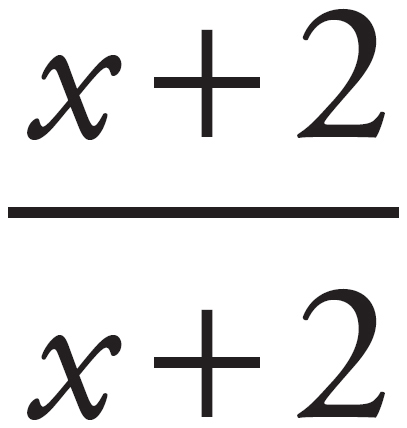1. C
This is a structure question. Why are the senior executives and directors who crafted and approved this statement publicly dragging employees into the commitments they’ve made? Using Process of Elimination, (A) is gone quickly—the authors do take responsibility at the end, when they refer readers to the most senior leader, the Chairman and Chief Executive Officer. Eliminate (A) because the overall tone of the document is confidence and reassurance, not worry. Also eliminate (B), because the purpose of the passage is to show that all employees are a part of corporate responsibility, not just the ones the stakeholders are dealing with. Only (C) gives a reason that should result in a benefit to the company and to the authors: Now anyone who reads this document knows that meeting these responsibilities is part of everyone’s job at Pine Trail Timber and will expect employees to behave accordingly.
2. D
The context in which “obligations” is used will point the way to the best answer in this language use question. The word occurs in the sentence about suppliers—the companies that provide the products Pine Trail Timber uses in its own manufacturing—and is positioned as the second half of a two-part purchase transaction—specifying its requirements for the products it buys, and then meeting its obligations (i.e. to pay for those products). So while weak arguments could be made for (A), (B), and (C), choice (D) is the most accurate in this context.
3. A
This question asks you to compare information about Pine Trail Timber given in two different formats—text and figures in a table. However, that information does not portray quite the same company image. The text statement presents a company committed to responsible resource management and concern for employees, including workers’ safety. The table tells a rather different story. Even in Pine Trail Timber’s largest operations (North America), only 20.8% of the workers have earned safety certification, and the largest percentage of remediation workers (still only 3.8%) is found in Central America, which is only the company’s second largest area of activity.
Now to find the most significant difference or similarity, use Process of Elimination. Choice (C) is eliminated because the text statement doesn’t say anything about workers controlling their own safety, let alone being able to refuse dangerous work, as the table shows. Read the question carefully—you’re comparing topics covered by both of the two sources. While (B) has some truth, it’s hardly the most significant issue raised in a comparison. Choice (D) is also a weak similarity; having fewer than four percent of the workforce involved in remediation in even the area with the highest percentage isn’t much of a commitment to restoring the land. Choice (A) is the correct answer, and you can see it more easily from the percentages than from the absolute numbers. Southeast Asia lags the other three areas on all measures of concern for workers’ safety, for instance, while Africa has been more successful than the other areas in giving workers a voice in safety (through workers’ committees and representatives, and through exercising the right to refuse dangerous work).
4. B
The question is about the authors’ motives for publishing the document, and there is no indication that they are required to do so, nor is there indication about what their competitors have done, so eliminate (A) and (C). Your answer choice should be based only on what’s in the passage. Choice (D) is eliminated because the CSR statement outlines the company’s commitments in carrying out its mission, not the mission itself. That leaves only (B) as the correct answer: Overall, the document is intended to convey a positive public image of the company.
5. This is an evaluation question that would be presented in an actual test in the drag-and-drop format. You’re asked to decide how well the company supports its claims, or whether it supports them at all. The first and third claims—(a) and (c)—are supported by FSC certification and by the invitation to contact the company’s Chairman and CEO. The references to a rising stock price and five years of dividend increases support the last claim (f). Since all six claims fit somewhere in the chart, the remaining three must go into the “not supported” column. Indeed, the second and fifth claims—(b) and (e)—are made without any support, and the fourth claim (d) isn’t even directly made, let alone supported.
6. A
In this tricky main idea, or theme, question, you need to find themes not only in the two paragraphs identified, but also in the CSR statement as a whole. Using your critical thinking skills, you’ll recognize that the correct answer will identify something inconsistent in those themes. The only choice that does that is (A). If Pine Trail Timber is such a trustworthy custodian, why are there investigations and sufficiently large-scale events to create an impact beyond the company’s operations? The need for remediation, mentioned in paragraph 15 of the “Respect for the Environment” section, reinforces the apparent disconnect between the image the company portrays and the actual results of its operations. Each of the other three choices may contain a grain of truth, but does not lead to the significant conclusion with relation to the overall theme of responsible corporate citizenship that (A) does.
7. D
This is a development question of the building block type. What is the most significant addition to the company’s image as a responsible resource manager that is made by the concept of employees planting trees and teaching others how to care for them? Choice (C) can be eliminated quickly; it’s doubtful a company in the business of felling trees would be attractive to environmentally conscious recruits. Choices (A) and (B) are true as far as they go, but this is a forestry company, so there’s a more direct link than that. Choice (D) provides that direct link to the company’s business by pointing out that employees help renew some of the resources the company uses.
1. C
To reach the correct answer for this structure question, you need to understand how the passage as a whole is built and then translate that understanding into a graphic shape. Think about the narrators: The passage begins with a first-person (“I”) narrator who is talking to the Leopard Man; then the Leopard Man takes over the narration as he tells the story of Wallace and De Ville. It’s (C)—a frame (the Leopard Man’s story) within a frame (the first-person narrator’s story about talking to the Leopard Man). None of the other shapes describes the structural characteristics of the passage. It doesn’t begin with a large-scale picture and filter down to particular events or characters (A). It doesn’t lead the reader through a confusing trail of dream sequences or shifts in time periods (B), and it doesn’t keep circling back around the same circumstance (D).
2. D
Here we’re looking at the author’s purpose in giving such a detailed account of the Leopard Man’s boredom. The Leopard Man doesn’t think taming big cats is exciting or dangerous, he shrugs off his injuries and, for an hour, he can’t even think of a thrilling circus story to tell the narrator. His attitude doesn’t seem suited to his profession and neither does his small, weak physical build. The author considered that important enough to devote a lot of effort to conveying it. Why?
Let’s start with Process of Elimination. Eliminate (A) because it’s not the author’s purpose to inform us about any profession; the passage focuses only on this one individual. Eliminate (B) because it’s not the author’s purpose to blame the Leopard Man’s attitude on the result of aging, but rather to contrast that attitude with his profession. Choice (C) has some truth to it: Big, fearless Wallace the lion tamer is gone and the feeble, bored Leopard Man is still here. That’s not the most important goal achieved by the detailed description of the Leopard Man, though.
The answer is (D). The narrator says, “He was the Leopard Man, but he did not look it” (paragraph 1). In the Leopard Man’s story, De Ville hadn’t taken his revenge for months, but that didn’t mean he wasn’t planning to. Things aren’t always what they seem—that’s one of the main points in the Leopard Man’s story and in the narrator’s description of the Leopard Man.
3. C
Look at the context around the quote to find the answer to this language use question. The quote occurs right after the narrator mentions the Leopard Man’s right arm, which “looked as though it had gone through a threshing machine” (paragraph 4). The quote doesn’t apply to the whole man, as advancing age and boredom with a career would, so (B) and (D) are eliminated. That leaves (A) and (C), and you need to compare them carefully. The reference to “claws and fangs” suggests some type of damage, which both of those choices also suggest. Choice (A) specifies performing with leopards. In the passage, however, the Leopard Man also talks about fighting lions and a tigress. Choice (C), which refers to big cats, is therefore the correct answer.
4. A
A couple of brief statements in the passage eliminate two choices in this comparison question. The Leopard Man admits, “I was beginning to think it all a scare over nothing” (paragraph 12) when nothing had happened for several months, so he ended up underestimating De Ville, too, eliminating (C). Wallace laughed off the Leopard Man’s final warning, but “he did not look so much in Madame de Ville’s direction after that” (paragraph 11), so he didn’t completely ignore all warnings, eliminating (B). If you’re not reading actively in a long passage such as this, it’s easy to miss these little clues.
Now we’re down to (A) and (D). Wallace “was afraid of nothing alive or dead” (paragraph 9), but there’s no indication that he relied on physical strength for his courage, and the Leopard Man mentions only De Ville’s quick temper, not his cleverness, so (D) is out. That leaves (A). The Leopard Man let his guard down after several months passed without any sign of revenge from De Ville, and Wallace let his guard down in the dressing tent; he was “too busy to notice” (paragraph 13) De Ville’s look of hatred or De Ville passing close behind him.
5. This plot development question is trickier than most because some of the events didn’t happen in the passage. There are eight events and only five spots in the chart, so first try to eliminate the three that didn’t occur. Those are the third one (c) (the Leopard Man, not Wallace, notices the hatred), the fifth event (f) (Wallace never tries to talk to De Ville), and the last one (h) (De Ville never reveals his intention to anyone).
Now you’re ready to select the order of the five events that do take place in the passage. De Ville’s wife looking at Wallace is what starts the whole chain of events, so that’s the first one (d). Warnings from several people in the circus follow (g), and then Wallace stops looking at De Ville’s wife after the Leopard Man gives his final warning (a)—those are the second and third events, respectively. The fourth event occurs when the Leopard Man watches De Ville walk behind Wallace, to plant the snuff (b). Augustus sneezing is what finishes Wallace off (e), so that’s the last one.
6. B
In this evaluation question, you need to consider whether anything in the plot doesn’t “add up.”
There is some question of support in (A). There is no apparent relationship that would prompt the Leopard Man to care enough about Wallace’s fate to warn him. On the other hand, there’s no reason he wouldn’t, either, especially when other people in the circus were giving warnings, too. So let’s eliminate (A)—we’re looking for the weakest support. Choice (C) is supported: Wallace isn’t afraid of anything. Choice (D) is supported, too. Augustus didn’t intend to bite Wallace’s head off; he simply sneezed.
So we’re left with (B). De Ville’s months of hatred followed by his grisly revenge aren’t explained in the passage. We’re simply told that De Ville is quick to anger, not that he holds a grudge for months despite a correction in the behavior that caused it.
7. A
This is a version of the main idea or theme question as it applies to a literary passage. After reading all of the details, from your 10,000-foot perch, what moral is the author conveying in this passage?
Process of Elimination leads smoothly to the correct answer. There’s no indication of a struggle with nature in the passage. The only “nature” is indicated by the big cats, who are represented as easy to manage (paragraph 3) or completely trusted (paragraph 8). That eliminates (B). Choice (C) is close: Wallace laughed off warnings about De Ville. However, he didn’t see De Ville as an opponent, either, which eliminates this answer. Choice (D) is too general. In being attracted to another man’s wife, Wallace may have been thinking the grass would be greener on the other side of the fence—a fatal error, in this case. However, that wouldn’t necessarily apply in every situation, eliminating (D).
So we’re left with (A). Wallace has the advantage in size and fearlessness (brawn), but De Ville has the advantage in brains, and that’s what defeats Wallace. De Ville waits months before taking his revenge, lulling even the Leopard Man into a sense of false security; then he figures out how to get the trusted Augustus to do the job for him.
The fourth choice is correct for the first drop-down question:
The harsh winter kept people at home more this year, too, which meant fewer customers, even on weekends.
The first answer presents a problem with word choice. “Less” is used for things that can’t be counted or for units of measurement (e.g. He has less time than expected to complete the project.); “fewer” for people or things. This answer is also missing the signal word “too.” While that’s not necessarily a mistake, the signal word does improve clarity by helping the reader understand that the writer is building up points to support his explanation for the loss of business.
The second choice is too wordy. (A harsh winter most likely would have an effect since the beginning of the winter.) The third choice is wrong because there is no reason to capitalize “customers.”
The second choice is correct for the second drop-down question.
I participated in a local trade fair, the recent “Home Grown Goodness” food exhibition, and sponsored a booth for a local charity at the fall fair.
The first choice (starting the sentence with “Participating” instead of “I participated,” and then beginning a new sentence with “I sponsored”) results in a sentence fragment. The third choice fails to set off the apposition with commas. (The trade fair and the “Home Grown Goodness” food exhibition refer to the same thing and perform the same function in the sentence.) This is the only choice that does not have those commas, which suggests that it’s incorrect. The fourth choice has a couple of problems: The structure isn’t parallel with the first part of the sentence, and the antecedent of “we” isn’t clear.
The first choice is correct for the third drop-down question:
I would, of course, welcome any suggestions you can offer.
The second choice creates a sentence fragment. (A dependent clause starting with “although” cannot stand alone.) The third choice has a dangling modifier. (The modifier, “Welcoming any suggestions…,” does not describe the subject of the sentence, “you.” It describes the writer.) The third choice is also wordy. (“Suggestions” and “ideas” refer to the same thing.) The fourth choice is an ugly run-on sentence and is not consistent with the formal tone of the rest of the email.
In the final drop-down question, the third choice is correct:
However, I hope that my excellent credit record and my long business relationship with your bank would make me eligible for special consideration.
The first choice contains two pronoun errors: agreement (“their” is plural and bank is singular) and an unclear antecedent (it’s not even clear whether the pronoun is supposed to refer to the bank). Switching from “I” to the third-person pronoun, “their,” also creates a lack of parallel structure. The second choice is wordy (of course he was doing business with the bank during a long business relationship). It’s also the only choice in which the transition word “however” is missing. That transition word improves clarity by marking a change in direction. The final choice lacks parallel structure again: It changes from a noun (the writer’s credit record) to a verb (“I have”).
These two drills present different challenges that you might encounter in the Extended Response section. Below you’ll find suggested approaches to these challenges, and chains of reasoning you might follow in creating your responses to the prompts.
Building the Argument Use active reading to note each side’s arguments and support in the charts. That evidence is quite clearly laid out in these passages although, as you’ll read below, it’s challenging because the authors’ purposes are so different. Your chart might look like the one below.
Pro side (government document):
|
Argument
|
Support
|
|
increased energy security (Paragraph 3)
|
import 40% of petroleum (Paragraph 2)
price spikes, supply disruptions (Paragraph 2)
|
|
better fuel economy (Paragraphs 4 and 5)
|
electricity cheaper than gas (Paragraph 5)
|
|
flexible fueling (Paragraph 6)
|
different charging locations, gas for PHEVs (Paragraph 6)
|
|
lower costs (Paragraph 8)
|
fuel cheaper, future price reductions, government incentives (Paragraph 8)
|
|
lower emissions (Paragraph 9)
|
none for EVs, lower for HEVs and PHEVs (Paragraph 9)
|
Con side (father’s letter)
|
Argument
|
Support
|
|
limited range (Paragraph 14)
|
80 miles (Paragraph 14)
|
|
few charging stations (Paragraph 14)
|
5,000 in California (Paragraph 14)
|
|
long charging time (Paragraph 14)
|
8 hours (Paragraph 14)
|
|
high costs (Paragraph 15)
|
parts, batteries (5 years), initial price (2x) (Paragraph 15)
|
|
unsafe for highway (Paragraph 16)
|
70 mph maximum (Paragraph 16)
|
|
catch fire (Paragraph 17)
|
unspecified news reports (Paragraph 17)
|
Choosing Your Thesis Both sides give several arguments (although Dad has one more than the U.S. government). With one exception (the unspecified news reports of fires), the father also backs up his arguments with specific figures. The government document does in most cases, too, though. The U.S. government has more credibility as an author (one would hope the Department of Energy has professional experts who supplied the data), but the Office of Energy Efficiency and Renewable Energy also has a vested interest in promoting electric vehicles. Dad, on the other hand, has a parent’s genuine passion for protecting his child.
One factor that might give the edge to the Department of Energy is the scope of its concern (the well-being of the nation) as opposed to the father’s concern for one person. Other factors that weaken the father’s case are his reasoning and his assumptions. His visions of Melissa hanging around an isolated charging station all night and sleeping unaware while her car burns outside seem alarmist; he doesn’t provide any evidence to justify those leaps from electric vehicles to an endangered daughter. You could add to that the self-interest evident in his remark that, with the concern about safety on the highway, Melissa wouldn’t be able to drive home to visit her parents.
If you think you could make a better case for the father’s side being better supported, that would not be a wrong choice for a thesis. The Extended Response passages are designed to allow you to argue either side successfully. However, giving the edge to the government does seem an easier thesis to prove.
Organizing Your Argument Organizing specific pieces of evidence is a challenge in this example, since the authors’ purposes (and therefore their arguments) don’t overlap. Dad isn’t the least bit concerned with the government’s purpose (fostering energy security), and the government doesn’t address the father’s goal (safety).
The only minor overlap occurs in the discussion of cost; however, both sides approach that issue from different directions. For the government, the high initial cost of a vehicle is an acknowledged problem. (Any argument that acknowledges an opponent’s position gains some credibility.) This cost disadvantage can be offset by lower fuel costs and government subsidies, it argues. The father doesn’t mention those offsetting factors, and you have to wonder if he’s concerned about having to subsidize repairs or a replacement battery down the road.
Given the general lack of overlap and the fact that cost isn’t the main argument for either side, the best approach would be to discuss the evidence that proves your thesis first (the government’s arguments) and then point out the alarmist reasoning and unsupported assumptions that weaken the father’s case.
Writing the Essay You might take advantage of the two different purposes as an attention-getting opening question for your essay: “Energy security or driver safety: Which goal should decide the choice of a new car?” Your thesis statement and the high-level list of evidence come next: “In these two passages, the U.S. Department of Energy argues that electric vehicles would help protect the nation’s energy supply, while a father raises rather alarmist concerns for his daughter’s safety. The government’s position is better supported in virtue of its credibility and the nationwide scope of its concerns about energy security and lower emissions.”
That’s the first paragraph. You’d likely end up with a four-paragraph essay here and that’s fine, as long as your points are clearly organized in the middle two paragraphs. The second paragraph would discuss the evidence from the government’s position, and the third paragraph would outline the evidence from the father’s position, pointing out its weaknesses. As always, the final paragraph would restate the thesis in different words and remind readers about the evidence that proves the thesis.
Building the Argument Here’s a different version of the argument/support chart, with the arguments lined up beside each other. Arranging the chart in this way can help you decide which side you could do a better job of arguing.
Choosing Your Thesis Breaking these two passages down into an argument/support chart is quite revealing. The FDA has only one main reason for its pro-ban position, and it undercuts even that with statements such as “Antimicrobial resistance may not be completely preventable” (paragraph 5) and “even appropriate therapeutic uses of antibiotics can promote the development of drug-resistant bacteria” (paragraph 7). Its strongest points are the weight of the FDA name and the fact that it has been working with stakeholders across the industry (drug companies, producers, veterinarians, and consumer groups). On the other hand, the anti-ban side lays out four main reasons for its position. It counters the FDA’s argument by pointing to studies that don’t prove the link between antibiotic use and superbugs, as well as blaming other culprits (doctors who overprescribe antibiotics and consumers who don’t handle food safely). The main argument of the anti-ban side, however, is economic: Adding antibiotics to feed allows farmers to feed more people at a lower cost, keeps food prices low for consumers, and makes agricultural exports competitive. The FDA doesn’t even mention, let alone refute, those reasons. It also neglects an argument that would strengthen its own position: It makes only an indirect reference to the high cost (in human lives) of antibiotic-resistant diseases, and makes no mention of high costs to the health care system.
Regardless of your own opinion on the issue, it might be easier, looking at an argument/support analysis of the passage, to claim that the anti-ban side is better supported. Let’s call that your “for” side. The writer refutes the FDA’s reason for the ban and presents three economic reasons in favor of using antibiotics for growth and feed efficiency, including a specific number for the increase in farmers’ productivity (155 people fed). The case would be even better supported if the author had cited specific studies and dollar figures.
Organizing Your Argument It would be ideal if each side’s points lined up neatly, so you could discuss why your “for” side’s Point A is better supported than your “against” side’s Point A. Unfortunately, that doesn’t usually happen.
In this example, you would have to include your “against” side’s argument in favor of its position, since it makes only one and the prompt tells you to draw evidence from both passages. Luckily, your “for” side presents its case about the same point—the increase (proven or unproven) in antibiotic-resistant diseases as a result of antibiotics in farm animal feed. So that would be the first piece of evidence you’d discuss.
Your “for” side makes three more arguments, all of them tied to economic factors. It presents the strongest support for the argument about meeting the growing demand for food through more efficient production, since it gives a specific figure (the increase in the number of people fed per farmer) to support that argument. You’d discuss that point next, then.
The last two arguments can be combined neatly: Lower costs and faster time to market for the farmer mean lower food prices for consumers and more competitive exports. You might point out (if it occurred to you) that the FDA failed to present the economic argument it could have made: higher health care costs as a result of antibiotic-resistant illnesses. That would allow you to draw some more evidence for your thesis from the FDA passage.
Writing the Essay So now you have the thesis—the anti-ban case is better supported—and a plan for organizing your evidence.
It’s time to start writing, using the template. The anti-ban author even provides a strong “startling fact” opening for your essay: “Each American farmer today feeds an average of 155 people, six times more than in 1960” (paragraph 13). Of course, you’d paraphrase this in your essay (“According to the online farmers’ forum posting, each farmer feeds six times more people today than in 1960”) or else put it in quotation marks with the paragraph reference.
Then you’d state your thesis (that the anti-ban position is the best supported) and briefly mention the evidence noted in your chart. You might say something like, “That increased productivity is the chief argument in favor of adding antibiotics to farm animal feed. It’s the best supported argument, since it explains that the higher productivity leads to meeting ever-increasing demand for food and keeping costs low for both domestic and export customers. The side arguing for a ban on antibiotics doesn’t support its one argument with credible evidence that the practice leads to the rise of antibiotic-resistant illnesses. In fact, it even undercuts its own argument by suggesting alternate causes for these illnesses.”
The next three paragraphs—each one beginning with a topic sentence—will discuss the arguments you just mentioned (the antibiotic-resistant illnesses in paragraph 11, the higher productivity in paragraph 10, and the cost disadvantages in paragraph 12). In each paragraph, remember to explain how that evidence supports your thesis. The final paragraph restates your thesis in different words and wraps up your argument by summarizing the points you just made in the middle of the essay.
Reviewing Your Work Now, while you’re practicing, you have time to ask yourself the questions listed in Chapter 10 (see this page) to assess your own work. During the test, of course, you won’t. Then you’ll be reviewing your essay to revise it (Is something not clear? Is there a better way to say it?) and edit it (correcting grammar and spelling errors).
1. less than
Just use the values you were given to find the values of points A and B. A is –4 and B is –1, so A is less.
2. C
To find the distance, count the number of steps between A and B. The answer is 3.
3. C
Estimate. Roughly where will the midpoint of A and D fall? Point E will be between points 0 and 1.
1. 3,000
3,400 is less than 3,500.
2. 3.5
3.46 is greater than 3.45.
3. 600
565 is greater than 550.
4. $433
432.70 is greater than 432.50.
5. 4.80
This number already has a zero in the hundredths place.
1. 2
Adding a negative is like subtracting.
2. –11
3. 18
4. –12
Multiplying a negative by a positive always yields a negative.
5. 1
6. 5
7. 10
Multiplying a negative by a negative always yields a positive.
8. 3
Dividing a negative by a negative always yields a positive.
9. –4
Dividing a positive by a negative or a negative by a positive always yields a negative.
10. –4
1. 4
The number 4 is four units from the number 0 on the number line, so |4| = 4.
2. 7
The number –7 is seven units from the number 0 on the number line, so |–7| = 7.
3. 4
The number 6 is four units to the right of 2 on the number line, so |6 – 2| = 4. Alternatively, 6 – 2 = 4, so |6 – 2| = |4|. Since 4 is four units from 0 on the number line, |4| = 4. Either way, |6 – 2| = 4.
4. 2
The number 3 is two units to the left of 5 on the number line, so |3 – 5| = 2. Alternatively, 3 – 5 = –2, so |3 – 5| = |–2|. Since –2 is two units from 0 on the number line, |–2| = 2. Either way, |3 – 5| = 2.
5. 10 or –10
|x| = 10, so x is 10 units from 0 on the number line. It cannot be determined whether x is 10 units to the left or 10 units to the right of 0, so consider both possibilities. If x is 10 units to the left of 0, then subtract 10 from 0 to get x = 0 – 10 = –10. If x is 10 units to the right of 0, then add 10 to 0 to get x = 0 + 10 = 10. Therefore x =10 or –10.
6. 4 or 14
|y – 9| = 5, so y is five units from 9 on the number line. It cannot be determined whether y is five units to the left or five units to the right of 9, so consider both possibilities. If y is five units to the left of 9, then subtract 5 from 9 to get y = 9 – 5 = 4. If y is five units to the right of 9, then add 5 to 9 to get y = 9 + 5 = 14. Therefore y = 4 or 14.
Use PEMDAS for these.
1. 1, 2, 3, 4, 6, 9, 12, 18, 36
Start from the outside and work to the inside. Every number has 1 and itself as factors so 1 and 36 are factors. Now try 2. 36 ÷ 2 = 18, so 2 and 18 are factors. Now try 3. 36 ÷ 3 = 12, so 3 and 12 are factors. Now try 4. 36 ÷ 4 = 9, so 4 and 9 are factors. Now try 5. 36 ÷ 5 is a decimal, so 5 is not a factor. Try 6. 36 ÷ 6 = 6, so 6 is a factor. Since 6 has been repeated, stop here. The factors are 1, 2, 3, 4, 6, 9, 12, 18, and 36.
2. 1, 43
Start on the outside and work to the inside. Every number has 1 and itself as factors so 1 and 43 are factors. Now try 2. 43 ÷ 2 is a decimal, so 2 is not a factor. 43 ÷ 3 is also a decimal, so 3 is not a factor. 43 ÷ 4 is also a decimal, so 4 is not a factor. 43 ÷ 5 is also a decimal, so 5 is not a factor. 43 ÷ 6 is also a decimal, so 6 is not a factor. Continue through 42 to find that there are no other factors. Therefore, the only factors are 1 and 43.
3. 1, 2, 4, 5, 8, 10, 16, 20, 40, 80
Start on the outside and work to the inside: 1 and 80, 2 and 40, 4 and 20, 5 and 16, 8 and 10. Since 3, 6, 7, and 9 do not divide 80 evenly, these are not factors. Since the next number after 9 is 10, which is already on the list of factors, there are no other factors. The only factors are 1, 2, 4, 5, 8, 10, 16, 20, 40, and 80.
4. 7, 14, 21, 28, 35, 42, 49, 56, 63, 70
One way to find the first 10 positive multiples of a number is to multiply the number by all the whole numbers from 1 through 10. 7 × 1 = 7. 7 × 2 = 14. 7 × 3 = 21. 7 × 4 = 28. 7 × 5 = 35. 7 × 6 = 42. 7 × 7 = 49. 7 × 8 = 56. 7 × 9 = 63. 7 × 10 = 70. Therefore, the first 10 positive multiplies of 10 are 7, 14, 21, 28, 35, 42, 49, 56, 63, and 70.
5. 9, 18, 27, 36, 45, 54, 63, 72, 81, 90
One way to find the first 10 positive multiples of a number is to start with the number itself, and then add the number 9 more times. In this case, start with 9, as 9 is a multiple of itself. Add 9 to get 18. Add 9 to get 27. Add 9 to get 36. Add 9 to get 45. Add 9 to get 54. Add 9 to get 63. Add 9 to get 72. Add 9 to get 81. Add 9 to get 90. Therefore, the first 10 positive multiples of 9 are 9, 18, 27, 36, 45, 54, 63, 72, 81, and 90.
6. 16
Start by finding the factors of 32: 1 and 32, 2 and 16, and 4 and 8. Now, find the factors of 80: 1 and 80, 2 and 40, 4 and 20, 5 and 16, and 8 and 10. The common factors are 1, 2, 4, 8, and 16. The greatest of the common factors is 16. As a shortcut, first get the factors of 32, and then use the outside to inside method for finding factors of 80. The first common factor that is the greater number of a pair of factors must be the GCF. In this case, the first pair is 1 and 80. 80 is not a common factor. The second pair is 2 and 40. 40 is not a common factor. The third pair is 4 and 20. 20 is not a common factor. The fifth pair is 5 and 16. Since 16 is a common factor, 16 is the GCF.
7. 63
List the multiples of 9 until one is also a multiple of 7. The first six positive multiples of 9 are 9, 18, 27, 36, 45, and 54. None of these are multiples of 7. The next multiple, however, is 63, which is a divisible of 7. Therefore, 63 is a common multiple of 7 and 9. Any other common multiple has to be greater, so 63 must be the least common multiple.
8. 24
Find the factors of 24: 1 and 24, 2 and 12, 3 and 8, and 4 and 6. Now begin to use the outside to inside method to find the common factors of 48. The first pair is 1 and 48. Since 48 is not a factor of 24, it is not the GCF. The next pair is 2 and 24. Since 24 is also a factor of 24, it is a common factor. The only greater factor of 48 is 48, which is not a common factor. Therefore, the greatest common factor of 24 and 48 must be 24.
9. 48
List the multiples of 48 until one is also a multiple of 24. 48 is a multiple of itself. 48 ÷ 24 is a whole number, so 48 is a multiple of 24. Therefore, 48 is a common multiple and must be the least common multiple of 24 and 48.
1. 
Divide top and bottom by 3.
2. 
Divide top and bottom by 11.
3. 
Divide top and bottom by 7.
4. 
This fraction can’t be reduced. If you said  , you found the square root of top and bottom by mistake.
, you found the square root of top and bottom by mistake.
5. 
This fraction can’t be reduced.
1. 
Use the Bowtie method.
2. 
35 is the common denominator.
3. 
12 is the common denominator.
4. 
If you use the Bowtie for the first two numbers, you will already have the same denominator as in the third number.
5. 
21 is the common denominator. You can have a negative fraction!
1. 
First reduce the 4 on top and the 8 on bottom.
2. 
Invert and multiply. But before you multiply, divide top and bottom by 3 and then by 5.
3.  or
or 
Invert and multiply, but before you multiply, divide top and bottom by 2.
4. 
Cancel the 3s and the 4s, and you won’t have to multiply at all!
5. 
First, convert 1 to an improper fraction:
to an improper fraction:  . Then cancel the 3s.
. Then cancel the 3s.
1. C
Half of the 80 people tested originally had Lyme disease—that’s 40 people. Of the other 40 people, one quarter later developed Lyme disease. One quarter of 40 is 10. So a total of 50 got Lyme disease out of 80 people. 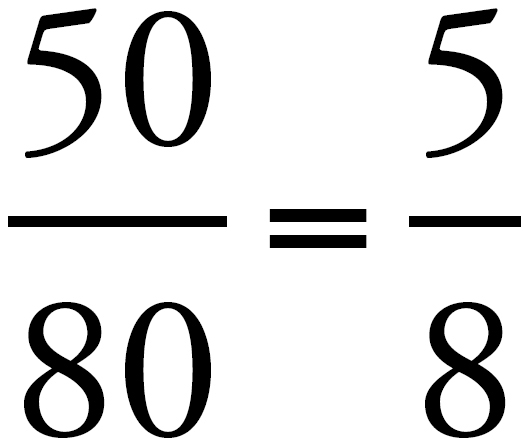 .
.
2. August: 110
September: 121
One tenth of 100 is 10, so in August they baked 110 pies. In September they increased production by another tenth. One tenth of 110 is 11. So in September, they baked 110 + 11 pies, or 121.
3. 
To work with these fractions, you need to find a common denominator: 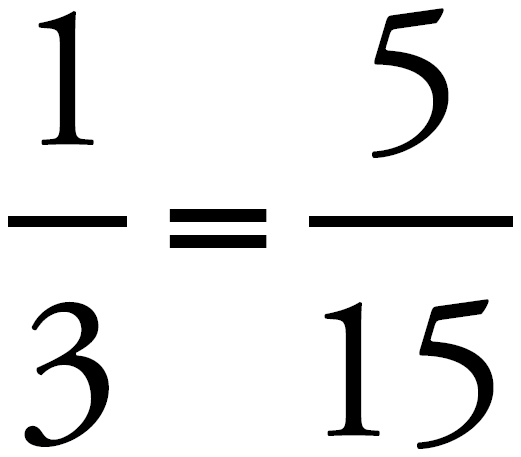 and
and  . So if
. So if  go by public transportation, and
go by public transportation, and  go by car, that adds up to
go by car, that adds up to  —which means that
—which means that  walk to work.
walk to work.
1. 7.06
2. 4.36
3. 8.194
Forget the decimals and just multiply. Then add up the numbers to the right of the decimals in the original numbers. That is how many places to move the decimal to the left in your new number.
4. 3,200
Set this up like a normal division problem. Then move the decimal place of the divisor as many times as it takes to turn the divisor into an integer. Now move the decimal in the dividend the same number of places, and divide as usual. You end up with 6,400 ÷ 2 = 3,200.
5. 40
Using the same methods you used in Question 4, you end up with 320 ÷ 8 = 40.
1. 16.6
Move the decimal over one place to the left, and then multiply by 2.
2. 4.5
Move the decimal over one place to the left, and then multiply by 3.
3. 288
Move the decimal over one place to the left, and then multiply by 4.
4. 2.1
Move the decimal over two places to the left, and then multiply by 3.
5. 9
Move the decimal over one place to the left, and then divide in half.
6. 100 + 15 = 115
7. 9.8 + 4.9 = 14.7
8. 3(14) + 7 = 49
9.  of 62 = 31
of 62 = 31
10.  of 144 = 36
of 144 = 36
1. greater than
Option X is 8% of $650, or $52. Option Y is 3% of $1,500, or $45.
2. C
Think about what’s left over: 40 percent of 1,200. Choice (A) was 60 percent of 1,200, which was a partial answer.
3. 903.61
Add the individual prices to get $120 + $635 + $74 = $829. Next, calculate $829 plus 9 percent of $829, or $74.61, for a total of $903.61.
4. D
The $8,437.50 for the year before is a red herring: It doesn’t have anything to do with this problem. The best way to do this problem is by working backward. Start with (B). What is 60 percent of $6,750? It’s only $4,050, which is less than the $5,400 you’re looking for. Go ahead and eliminate (A) and (B). Choice (D) is the next easiest answer to check. What is 80 percent of $6,750? That’s right, it’s $5,400. The answer to this problem is (D).
1. 0.6 and 
To get the decimal, just divide 5 into 3, or think “one-fifth = 0.2, so three-fifths = 0.6.” To get the fraction, multiply the numerator and the denominator by 3 to get the fraction 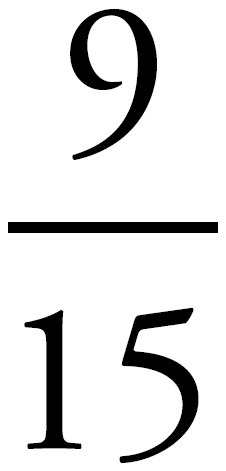 .
.
2. greater than
The total bill is $14.65 + $1.47 = $16.12, so 20 percent is $3.22. This is much larger than the tax, $1.47.
3. C
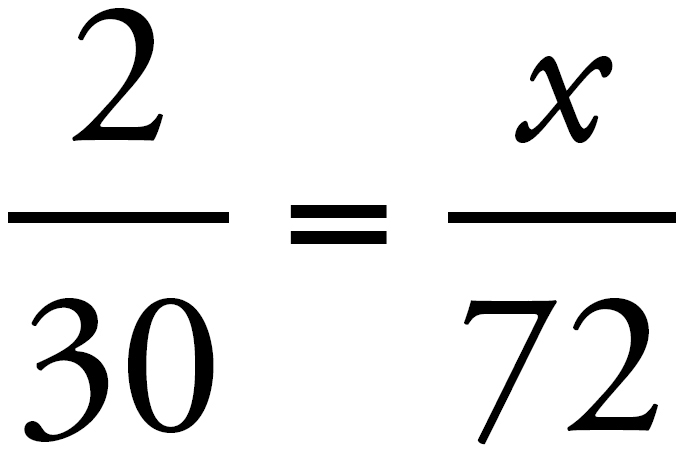 . Ballparking will get rid of (A) and (B).
. Ballparking will get rid of (A) and (B).
4. B
Add  and
and  , but look out for (A): It is a partial answer. We want what is left over, so subtract this from 1.
, but look out for (A): It is a partial answer. We want what is left over, so subtract this from 1.
5.
6. C
11 percent of $275 is $30.25. Add the two amounts ($275 + $30.25) to find the total, $305.25, and then divide by 12. The answer is $25.43, which rounds to $25.00, (C).
7. C
Use the distributive property to get 5(R – S) = 35. Divide both sides of the equation by 5 to get R – S = 7.
8. –1
Use PEMDAS, and be careful. The answer is –1.
9. C
 , which you can round up to 43 percent. Ballparking shows it will be just under 50 percent.
, which you can round up to 43 percent. Ballparking shows it will be just under 50 percent.
10. D
We can eliminate (A) and (B) because they are less than the amount paid. This is a good problem to do backward. Let’s start with (D), $12,000. What is 80 percent of $12,000? You guessed it: $9,600.
11. 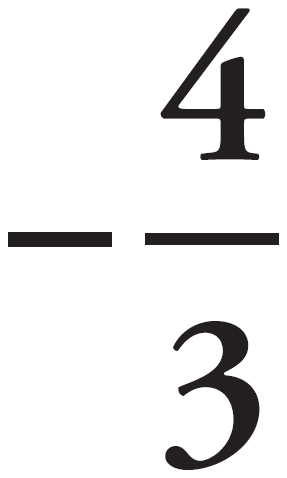 , –0.8,
, –0.8,  , 0.5,
, 0.5, 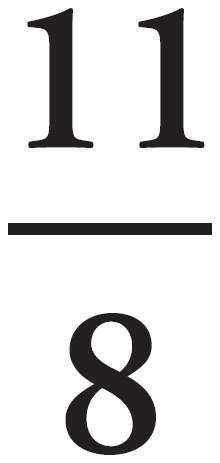 , 2
, 2
The question asks you to place fractions, decimals, and a whole number on a number line. Since decimals are easier to order than fractions, convert the fractions into decimals Turn  into a decimal by dividing 4 by 3 to get
into a decimal by dividing 4 by 3 to get 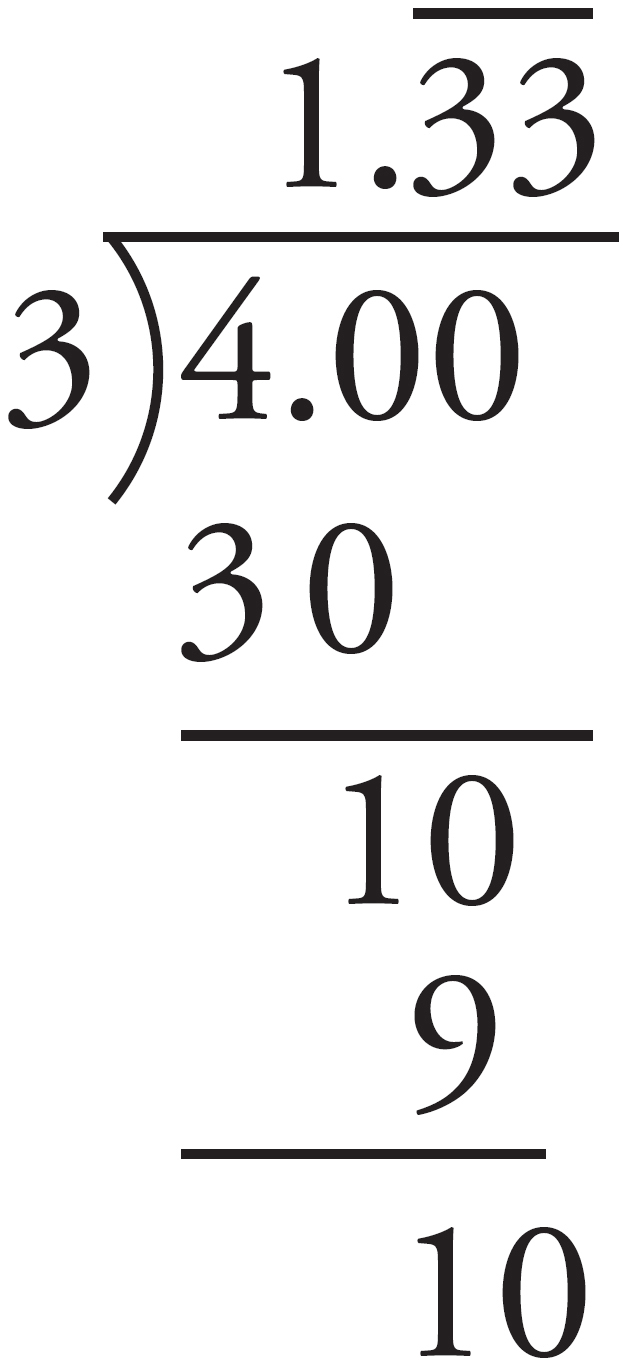 .
.
Bringing in the negative sign, 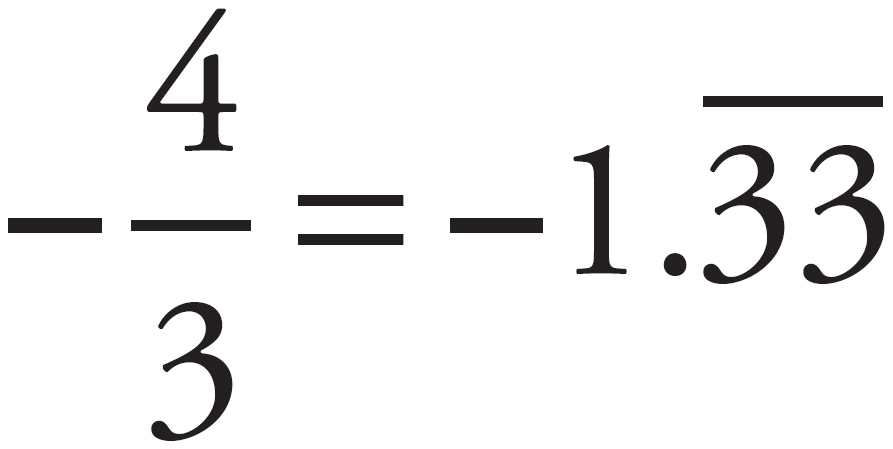 . Turn
. Turn  into a decimal by dividing 1 by 4 to get
into a decimal by dividing 1 by 4 to get  . Bringing in the negative sign,
. Bringing in the negative sign,  . Turn
. Turn 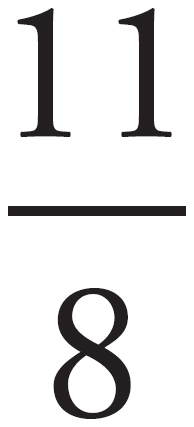 into a decimal by dividing 11 by 8 to get
into a decimal by dividing 11 by 8 to get  , so
, so  . Therefore, in decimal terms, the six numbers are 2, 0.5,
. Therefore, in decimal terms, the six numbers are 2, 0.5, 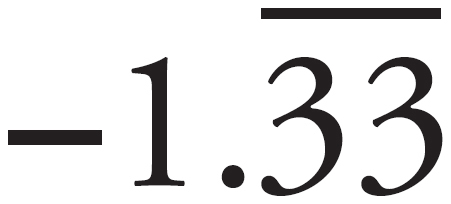 , –0.8, –0.25, and 1.375. Put these in order from least to greatest to get
, –0.8, –0.25, and 1.375. Put these in order from least to greatest to get  , –0.8, –0.25, 0.5, 1.375, and 2. Place these in the boxes from left to right. The correct answer is
, –0.8, –0.25, 0.5, 1.375, and 2. Place these in the boxes from left to right. The correct answer is  , –0.8,
, –0.8, 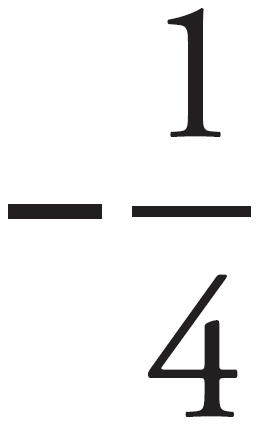 , 0.5,
, 0.5,  , and 2.
, and 2.
12. A
This question requires a few operations, including absolute value. We need to find the absolute value first.
|6 – (–5)| = |11| = 11
So this lets us simplify our problem to 14 – 11 × 3.
PEMDAS tells us that we need to multiply before subtracting.
11 × 3 = 33
So that gives us 14 – 33 = –19.
13. D
The question asks for the sum of the factors of 14. Start on the outside and work inward. 1 and 14 are factors of 14. Since 14 ÷ 2 = 7, 2 and 7 are factors. Since 14 ÷ 3 is a decimal, 3 is not a factor. Since 14 ÷ 4 is a decimal, 4 is not a factor. Since 14 ÷ 5 is a decimal, 5 is not a factor. Since 14 ÷ 6 is a decimal, 6 is not a factor. Since 7 is already on the list, the list is complete. Therefore the factors are 1, 2, 7, and 14, and the sum of the factors is 1 + 2 + 7 + 14 = 24. The correct answer is (D).
14. C
The question asks for which choice is NOT a multiple of 4. Divide each choice by 4. Any choice that can be divided evenly by 4 is a multiple. Choice (A) is 4. Since 4 ÷ 4 = 1, then 4 is a multiple of 4. Choice (B) is 12. Since 12 ÷ 4 = 3, then 12 is a multiple of 4. Choice (C) is 34, and 34 ÷ 4 = 8.5. Since this is a decimal, 34 is not a multiple. The correct answer is (C).
1. A
8 times 6 times 4 times $5.50.
2. B
The new cost is the old cost ($12,000) plus 0.04 times the old cost.
1. 327.60
An average is always equal to the sum of all the elements divided by the number of elements. So $23.40 = 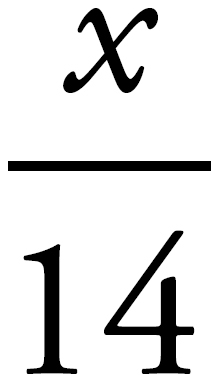 . Therefore, x = $23.40 times 14, or $327.60.
. Therefore, x = $23.40 times 14, or $327.60.
2.
3. C
Subtract the smallest amount, $35.77, from the largest amount, $73.23, to get $37.46.
4. D
Add up the total number of cones and divide by the number of days: 595 divided by 5 = 119.
5. B
Arrange the values in increasing order and then find the middle value.
6. C
50 percent is divided evenly between the midterm and final, each of which is weighted by 25 percent. The remaining 50 percent is divided evenly between the 5 tests, each of which is then weighted by 10 percent. Multiply the weight by each score and then add to get 88.2.
1. B

2. B

3. D
Not enough information is given. We have no method of comparison.
1. 4
If you set this up in the R × T = D format, it looks like this: ? × 3 = 12. The correct answer is 4 mph.
2. C
Just divide 5,280 by 4.
3. D
She drives 20 miles. If we deduct the hour she spent shopping, she drove the 20 miles in one hour.
1. D
First find 16 percent of 200 pounds, which is 32. Then multiply by 16 to find the number of ounces.
2. 5 c. flour; 2
c. flour; 2 c. sugar; 1
c. sugar; 1 c. butter; 2 eggs; 7 t. baking powder; 3 t. vanilla extract
c. butter; 2 eggs; 7 t. baking powder; 3 t. vanilla extract
If each of the 16 people eats 3 cookies, that is a total of 48 cookies. The original recipe makes 24, so double all the amounts to make 48.
1. B
Let’s say there were 100 telephones in all. If 45 of them were regular, then that number (45) is how many times greater than the number of cellular phones (15)? The answer is 3 times greater.
2. C
To ballpark this problem, first compare bottles A and B (which have the same number of ounces), and bottles C and D (which also contain the same number of ounces). Bottle A is cheaper than B, and bottle C is cheaper than D, so eliminate B and D. To find the exact price per ounce of each bottle, divide the price by the number of ounces. Bottle A costs 5 cents per ounce. Bottle C costs 3.3 cents per ounce. Bottle E costs 5 cents per ounce. The answer is bottle C.
3. B
Just ballpark, based on the chart.
1. D
23 = 8. Just try out the answer choices until you find the one that equals 8.
2. 31
27 + 4 = 31
3. D
4 – 2 = 2. Try out answers until you find the one that equals 2.
4. A
Since the number has a fractional exponent, rewrite  as
as  , and rewrite
, and rewrite 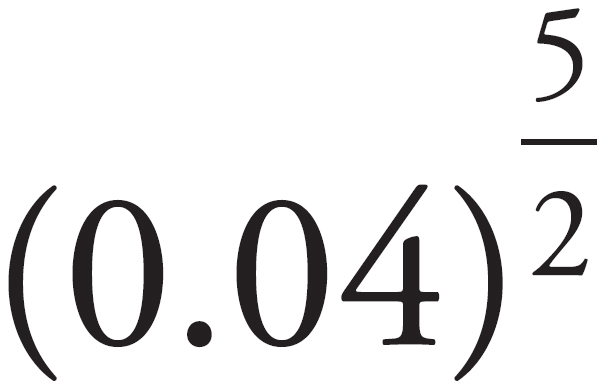 as
as  . Convert 0.04 into a fraction:
. Convert 0.04 into a fraction:  . Therefore,
. Therefore,  , so
, so  . To raise a fraction to an exponent, apply the exponent to both the numerator and the denominator to get
. To raise a fraction to an exponent, apply the exponent to both the numerator and the denominator to get  . Convert this to a decimal by moving the decimal point in both the numerator and denominator 5 places to the left to get
. Convert this to a decimal by moving the decimal point in both the numerator and denominator 5 places to the left to get  . The correct answer is (A).
. The correct answer is (A).
1. C
Multiply the 2,550 by 3 to get a total lumens of 7,650. Expand the answers until you find the one that matches this.
2. B
She has two green dresses, so your numerator will be 2. She has a total of six dresses, so your denominator will be six. Two out of six, or  .
.
3. D
3,400 + 41,000 = 44,400
1. D
Each choice is from a different source, so multiply by the number of possibilities from each source. This is 4 × 5 × 8 × 3 = 480. The correct answer is (D).
2. C
Each cabinet member is appointed from the same pool of candidates. Since each position is different, the order matters. Look at the number of choices for each position one at a time. There are eight candidates for vice president. After one is selected, seven candidates remain for secretary. After one is selected, six candidates remain for treasurer. Multiply these numbers to get 8 × 7 × 6 = 336. The correct answer is (C).
3. B
The teacher is choosing three team members from nine candidates. Because no positions or rankings are specified and each candidate is simply selected or not selected, order doesn’t matter. Look at the number of choices for each spot on the team, one at a time. There are nine choices for the first spot, leaving eight for the second, and seven for the third. Since order doesn’t matter, divide by the number of possible ordering of three team members, 3 × 2 × 1. This leaves  . The correct answer is (B).
. The correct answer is (B).
1. A
In this setup problem, you need to multiply 0.08 by $5,000 for one year, and then multiply that result by 2 for two years.
2. B
If you set this up in the rate times time format, you have 5 × ? = 17.5. The correct answer is 3 hours. You could have eliminated (C) and (D) by Ballparking.
hours. You could have eliminated (C) and (D) by Ballparking.
3. D
50 percent of 200 people is 100 and 40 percent of 200 people is 80. Subtract the two to find the difference.
4. D
Find the average of each answer with the three test scores given until you get an average of 90. Only (D) works. Add 94 + 88 + 85 + 93 to get 360. Divide 360 by 4 to get 90.
5. C
Don’t bother multiplying further than you have to—it’s clear (A) is way too big, for example. Five squared is 25 and the square root of 9 is 3. These values have a difference of 22, which is equivalent to (C).
6. B
The square root of 9 is 3. This is the closest the answer choices come to the square root of 10.
7. 
There are a total of 7 possible cars. There are 2 sedans. The odds on this probablility problem are 2 out of 7.
8. 12
Rearrange the numbers in ascending order. The middle number is 12.
9. B
To answer this setup problem, just convert the words into math. She works 40 hours at $14.50 and 3 hours at one and a half TIMES the $14.50 rate. The correct answer is (B). Choices (C) and (D) are wrong because we are supposed to add the two numbers, not multiply.
10. D
Expand out the scientific notation: 23,000 microns versus 32,000 microns. The difference is 9,000 microns.
11. C
Marie is choosing three shows, so leave three spaces for the shows. There are 5 possible choices for the first show, 4 remaining possible choices for the second show, and 3 remaining choices for the third show. Since she has to choose an order, do not divide and simply multiply the three numbers. 5 × 4 × 3 = 60.
12. A
In the numerator, there are two factors with bases of 2. When multiplying numbers with the same base, add the exponents: (212)(25) = 217, so the fraction is equal to  . There is a factor with a base of two in the denominator. When dividing numbers with the same base, subtract the exponents:
. There is a factor with a base of two in the denominator. When dividing numbers with the same base, subtract the exponents: 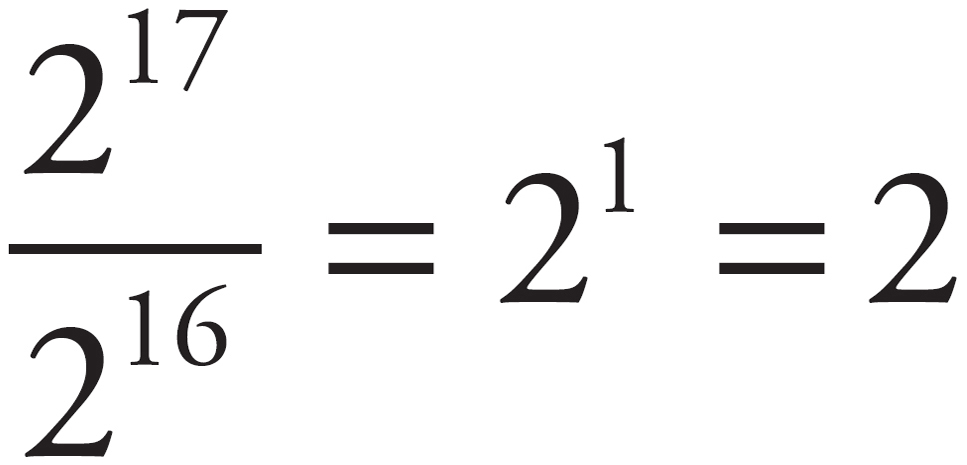 , so the fraction is equal to
, so the fraction is equal to  . In the numerator, there is a
. In the numerator, there is a  , which is equivalent to
, which is equivalent to  , so the fraction is equal to
, so the fraction is equal to  . When a number with an exponent is raised to another exponent, multiply the exponents:
. When a number with an exponent is raised to another exponent, multiply the exponents:  , so the fraction is equal to
, so the fraction is equal to  . Once again, numbers with the same base are divided. Subtract the exponents. Since the denominator is greater, keep the result in the denominator:
. Once again, numbers with the same base are divided. Subtract the exponents. Since the denominator is greater, keep the result in the denominator:  , so the fraction is equal to
, so the fraction is equal to  . The correct answer is (A).
. The correct answer is (A).
1. C
Add 5 to both sides of the equation, and then divide both sides by 2.
2. 15
Subtract 6 from both sides of the equation, and then divide both sides by 3.
3. C
Just plug in 2 for x and 3 for y.
1. C
If the minimum age is five, then anyone five or older can ride the roller coaster.
2. A
Just solve as if this were an equality.
3. C
Plug in 4 into each inequality until one is a true statement.
1. A
First, ballpark. If Marcie sees more patients, then she must see more than half of them. The answer must be more than 8, which eliminates every answer choice but (A). If you didn’t notice that, how could you have solved the problem? By Backsolving. Try (C) and say that Marcie saw 5 patients. If Marcie saw 2 more than Lewis, then Lewis saw 3 patients. When you add together Marcie and Lewis’s patients, you are supposed to have 16. Could this be the right answer? No way. You need a bigger number. Try (B). If Marcie had 7 patients, Lewis has 5, and this is still too small. The correct answer must be (A).
2. D
This is another good backsolve. Just try putting the values in the answer choices into the equation until you find one that works.
3. B
Ballparking gets rid of (A) because the problem says there are some men workers as well. If you solve this algebraically, watch out for (D), which turns out to be the number of men. However, a good way to avoid any chance of making a mistake is not to use algebra—try Backsolving instead. Start with (B). If there are 60 women and 4 times as many women as men, then the number of men is  of 60 or 15. If 60 + 15 = 75, then this is the answer. And it is.
of 60 or 15. If 60 + 15 = 75, then this is the answer. And it is.
4. B
Again, it is much easier to backsolve. Start with (C), 10%. Ten percent of $45.00 is $4.50. This is too much, so go down one and find 9 percent of $45.00. This is the correct answer.
5. D
You could use algebra, but Backsolving is just as easy. Start with (B), and see if it makes the equation work. No, we need a bigger number. Choice (C) doesn’t work either, so the answer must be (D).
1. C
Choice (A) is just Sandra’s weight alone. The combined weight of both of them is x + (x + 5), which is equivalent to (C).
2. B
The 2000 figure is just a red herring. It doesn’t matter that the number of rabbits doubled in 2000 because by 2001 (the year we are interested in), the population is up five times.
3. C
Choices (A) and (B) don’t multiply Sam’s age by 3. Choices (B) and (D) subtract years.
4. C
There are a total of nine chips, so set up the equation B + R = 9. The blue chips are worth 5 points each, so they’re worth 5B total. The red chips are worth 3 points each, so they’re worth 3R total. Since the blue chips and red chips combined are worth 21 points, 5B + 3R = 21.
1. A
Add up the total number of x’s and y’s.
2. B
Start by factoring an x out of the first two terms and 3 out of the last two terms. Both leave you with a factor of (x – 4).
3. B
Even though the coefficients are fractions, follow the same method. The first two terms both have a factor of 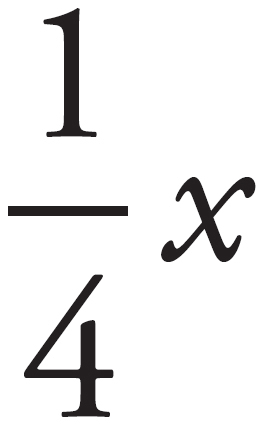 . Factor this to get
. Factor this to get  . The other two terms both have a factor of
. The other two terms both have a factor of  , so factor this to get
, so factor this to get  . Thus the original expression factors to
. Thus the original expression factors to  . Notice that the remaining terms both have factors of (x + 2). Factor this to get
. Notice that the remaining terms both have factors of (x + 2). Factor this to get  . The correct answer is (B).
. The correct answer is (B).
4. C
When multiplying polynomials, use the distributive property: (x2 + 2x + 8) (x – 4) = (x2 + 2x + 8)(x) – (x2 + 2x + 8)(4). Now use the distributive property on the remaining terms: (x2 + 2x + 8)(x) = x3 + 2x2 + 8x and (x2 + 2x + 8)(4) = 4x2 + 8x + 32. Therefore, the expression is (x3 + 2x2 + 8x) – (4x2 + 8x + 32). Distribute the negative to get x3 + 2x2 + 8x – 4x2 – 8x – 32. Group like terms to get x3 + (2x2 – 4x2) + (8x – 8x) – 32. Combine like terms to get x3 – 2x2 + 0 + 32 = x3 – 2x2 – 32. The correct answer is (C).
5. B
Translate the pieces of the question. A player’s score is the sum of the squares of the numbers on her cards. Let the two numbers be represented by x and y, respectively. The squares of the two numbers are x2 and y2, respectively, so their sum is x2 + y2. Jennifer’s cards have a product of 24, so xy = 24. The pairs of factors of 24 are 1 and 24, 2 and 12, 3 and 8, and 4 and 6. Since the cards cannot have numbers greater than 10, eliminate 1 and 24 and 2 and 12 as possible pairs. The sum of Jennifer’s cards is 11, so x + y = 11. Since that is the case, the two cards cannot be 4 and 6, since their sum is 10 rather than 11. Therefore, x and y must be 3 and 8. It cannot be determined whether x = 3 and y = 8 or x = 8 and y = 3. However, either possibility leads to the same result. Jennifer’s score is x2 + y2 = 32 + 82 = 9 + 64 = 73. The correct answer is (B).
1. A
Factor the equation. What two numbers have a sum of –7 and a product of 12. The factors of 12 are 1 and 12, 2 and 6, and 3 and 4. The factors 3 and 4 have a sum of 7. Since 7 is negative, the factors must both be negative, so the equation factors to (x – 3)(x – 4) = 0. Set both factors equal to 0. If x – 3 = 0, then add three to both sides to get x = 3. If x – 4 = 0, add four to both sides to get x = 4. The correct answer is (A).
2. B
The answer choices are in square form, so use the complete the square method. In this equation, b = –10, so, to have a perfect square, c has to equal 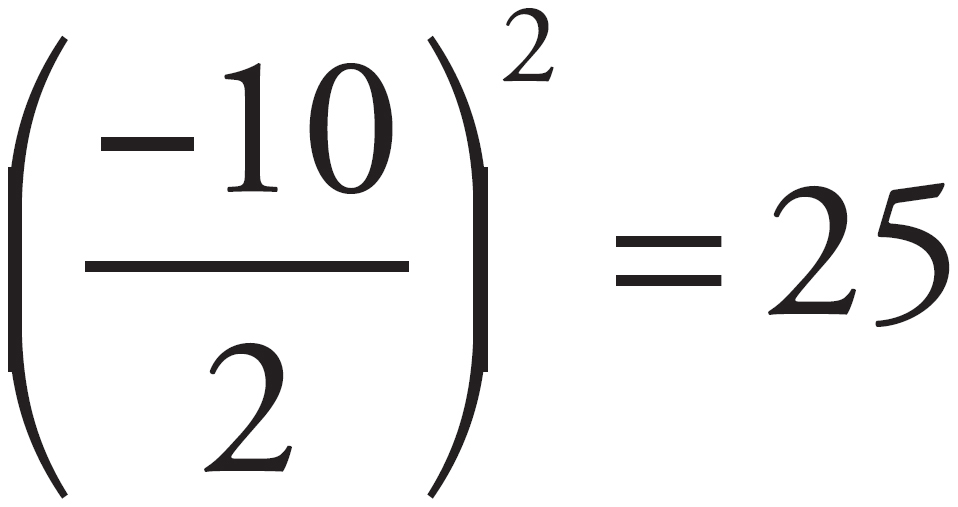 . To get c = 25, add 9 to both sides to get x2 – 10x + 25 = 9. Factor the left side to get (x – 5)2 = 9. The correct answer is (B).
. To get c = 25, add 9 to both sides to get x2 – 10x + 25 = 9. Factor the left side to get (x – 5)2 = 9. The correct answer is (B).
3. D
The answer choices are in the form of the quadratic formula, so use  . in the equation x2 – 8x + 5 = 0, a = 1, b = –8, and c = 5. Plug these into the quadratic formula to get
. in the equation x2 – 8x + 5 = 0, a = 1, b = –8, and c = 5. Plug these into the quadratic formula to get  . The correct answer is (D).
. The correct answer is (D).
1. C
Since both equations are isolated for x, set the two equal to each other, giving you 2y + 5 = 3y – 6. Subtract 2y from both sides and add 6 to both sides to get y = 11. Plug the value back into one of the original equations to get x = 27.
2. A
Line up the two equations. Since the question asks for the value of y, eliminate x. Multiply the first equation by 2 to get 6x + 8y = –10 and second equation by 3 to get –6x –15y = 24. Add the two equations to get –7y = 14. Divide by –7 to get y = –2.
3. A
Translate the information into a system of equations. Let A represent the number of apples and B represent the number of bananas that Bill bought. Bill buys a total of 8 apples and bananas, so A + B = 8. Each apple costs 25 cents, so the cost of A apples is 0.25A. Each banana cost 30 cents, so the cost of B bananas is 0.30B. Since the total cost is $2.15, then 0.25A + 0.30B = 2.15. Line up these two equations. Multiply the second equation by –4 to get –A – 1.20B = –8.60. Add the two equations to get –0.20B = –0.60. Divide both sides by –0.20 to get B = 3.
1. B
A relation is a function if every member of a domain corresponds with a unique member of the range. In the table, 3 corresponds with both –1 and y. In order for h(x) to be a function, these values must be the same, so y must equal –1.
2. B
Plug in 5 for each value of x, so g(5) = 52 – 6 × 5 + 9 = 25 – 30 + 9 = 4.
3. A
This is a translation problem. “The function of x” translates to f(x). “Is” translates to =. “Three times” translates to 3( ), with whatever follows filling in the parenthesis. What follows translates to “four more than,” so fill this is to get 3( + 4), with whatever follows filling in before the plus sign. Finally, what follows is “the square of x,” which translates to x2. Therefore, the entire function translates to f(x) = 3(x2 + 4).
1. C
Subtract 9 from both sides, and then divide both sides by 5 or backsolve.
2. A
Use translation: 3x + 4.
3. 29
Just plug in 3 for x and 4 for y.
4. C
This is a good Backsolving problem. If you start with (B), you’ll see it’s too small, so go up to the next biggest answer and try that.
5. B
Treat this just like an equality and solve for m. Simply subtract 7 from both sides to get 3m < 21. Then divide both sides by 3 to get m < 7. The correct answer is (B).
6. D
First distribute the 2 in the parenthesis to get 2x + 2y, and then add the total number of x’s and y’s.
7. D
Plug 4 into each of the answer choices until you find the one that is true.
8. C
You can ballpark this: 30 workers would be one-quarter, or 25 percent. 36 workers would be slightly more. Or work backward: What is 10 percent of the 120 workers? That’s right: 12. Twenty percent? 24. Thirty percent? 36. Bingo!
9. A
Use FOIL.
10. C
This is a great Backsolving problem. Start with (B). If Tony is 20, then Heather is 20 – 4 = 16, and Larry is 16 + 5 = 21. The sum of their ages is 20 + 16 + 21 = 57. This is too low. Try this with (C) and you’ll see that the ages add up to 69. The correct answer is (C).
11. A
Put the two equations in the same form, so that you can use linear combinations. Take the first equation and subtract 2 from both sides and add 2y to both sides to get 3x + 2y = –2. Now, to cancel x, multiply the second equation by 3 to get –3x + 9y = –42. Add the two equations to get 11y = –44. Divide both sides by 11 to get y = –4.
12. To determine the blank space on the top right, plug –2 in for x to get f(–2) = 2(–2)2 + 1 = 9. Select this for this blank space. To determine the blank space on the bottom left, plug in the answer choices to f(x) and select the one for which f(x) = 19. Ballpark out 17 and 19, and try the remaining choices. f(5) = 51, so the answer has to be smaller. Ballpark out 9, as well. f(–3) = 19, so this is the correct answer. Select –3 for this blank.
13. A
The question involves multiplication of rational expressions, so simplify the expressions by factoring. Factor –2 in the first numerator to get –2(x – 4). Factor the denominator of the first fraction to get (x – 5)(x + 2). The numerator of the second fraction factors to (x – 5)(x + 4). The denominator of the second fraction factors to (x + 4)(x – 4). Therefore, the factored form of the equation is  . Now look to cancel. Cancel (x + 4), (x – 4), and (x – 5) to get
. Now look to cancel. Cancel (x + 4), (x – 4), and (x – 5) to get  . Get all the variables on one side of the equation by multiplying both sides by (x + 2) to get –2 = (x + 5)(x + 2). Use FOIL on the right side to get –2 = x2 + 7x + 10. Since the right side is now a quadratic, get one side equal to 0 by adding 2 to both sides to get 0 = x2 + 7x + 12. Factor the right side to get 0 = (x + 3)(x + 4). Set both factors equal to 0 to get x + 3 = 0 and x + 4 = 0. Subtract 3 from the first equation to get x = –3 and 4 from the second to get x = –4. Since –4 is one of the choices, the correct answer is (A).
. Get all the variables on one side of the equation by multiplying both sides by (x + 2) to get –2 = (x + 5)(x + 2). Use FOIL on the right side to get –2 = x2 + 7x + 10. Since the right side is now a quadratic, get one side equal to 0 by adding 2 to both sides to get 0 = x2 + 7x + 12. Factor the right side to get 0 = (x + 3)(x + 4). Set both factors equal to 0 to get x + 3 = 0 and x + 4 = 0. Subtract 3 from the first equation to get x = –3 and 4 from the second to get x = –4. Since –4 is one of the choices, the correct answer is (A).
1. 40 degrees
180 – 140 = 40
2. 90 degrees
180 – 90 = 90
3. 130 degrees
180 – 50 = 130
1. square
All sides are the same length.
2. rectangle
The sides are different lengths, but all angles are right angles.
3. 9
Multiply length by width: 3 × 3 = 9
4. 24
Add the four sides together: 3 + 3 + 9 + 9 = 24. (The area of Figure B would be 27.)
5. 3
Divide the area of the rectangle by the area of the square: 27 ÷ 9 = 3.
6. 5
3 × 4 × ? = 60
7. 4
The entire volume of the cube equals 8, so halfway is 4.
8. D
Because you don’t know how much the wallpaper costs, there is not enough information given for you to answer the question.
1. B
Area is base times height divided by two. If you picked (A), you forgot to divide by two.
2. 2
This is a 3-4-5 triangle. The answer is 5 – 3 = 2.
3. C
180 – (27 + 53) = 100.
4. D
First, use the formula provided on the Mathematics Formula Sheet to find the surface area of the pyramid, 5,068.8. Since one can covers 1,296 square inches, two cans cover 2,592 square inches, 3 cans cover 3,888, and 4 cans cover 5,184. Only (D) is large enough to cover the surface area.
5. D
Adding up the three angles of the triangle, you get x + 2x + (x + 20) = 4x + 20 = 180. Solving for x, you get 40 degrees—but the question is asking for angle A, which is 2x or 80 degrees.
6. C
The question gives the volume of a pyramid. The formula for volume of a pyramid is  , where B represents the volume of the base and h represents the height of the pyramid. The question gives the volume and height, so plug these into the formula to get
, where B represents the volume of the base and h represents the height of the pyramid. The question gives the volume and height, so plug these into the formula to get  . Simplify the right side to get 320 = 5B. Divide both sides by 5 to get B = 64. Therefore, the area of the base is 64. Since the question says that it is a square base, use the area formula A = s2. Plug in A = 64 to get 64 = s2. Take the square root of both sides to get 8 = s. The question asks for the perimeter of the base. Perimeter is the sum of the lengths of all sides. Since the base is a square, all sides have a length of 8. Therefore, the perimeter is 8 + 8 + 8 + 8 = 4(8) = 32. The correct answer is (C).
. Simplify the right side to get 320 = 5B. Divide both sides by 5 to get B = 64. Therefore, the area of the base is 64. Since the question says that it is a square base, use the area formula A = s2. Plug in A = 64 to get 64 = s2. Take the square root of both sides to get 8 = s. The question asks for the perimeter of the base. Perimeter is the sum of the lengths of all sides. Since the base is a square, all sides have a length of 8. Therefore, the perimeter is 8 + 8 + 8 + 8 = 4(8) = 32. The correct answer is (C).
1. B
The perimeter is the sum of the sides, so 8 + 10 + x + 14 = 40. Simplify the left side to get 32 + x = 40. Subtract 32 from both sides to get x = 8. The correct answer is (B).
2. D
The question asks for the area of the octagon and gives a formula in terms of the side. Although the side is not given, the perimeter is given as well as the fact that it is a regular octagon. A regular octagon has eight equal sides, so the perimeter P = 8s. Since P = 56, 56 = 8s, and s = 7. Plug this into the formula to get  . None of the answer choices are in factored form, so distribute the 98 to get
. None of the answer choices are in factored form, so distribute the 98 to get  . The correct answer is (D).
. The correct answer is (D).
1. 4
2. 8
Multiply the radius by 2: 4 × 2 = 8.
3. 8π
The diameter is 8, so multiply that by π to get the circumference.
4. 16π
Use the formula for area: π42 = 16π.
5. 81π
The area of the circle is 9π. 9π × 9 = 81π.
6. A
If the diameter is 4, then the radius is 2. Substitute 2 in the formula for the surface area of a sphere: SA = 4πr2. Then, SA = 4π22 = 4π22 = 16π.
7. C
The formula for volume of a cone is 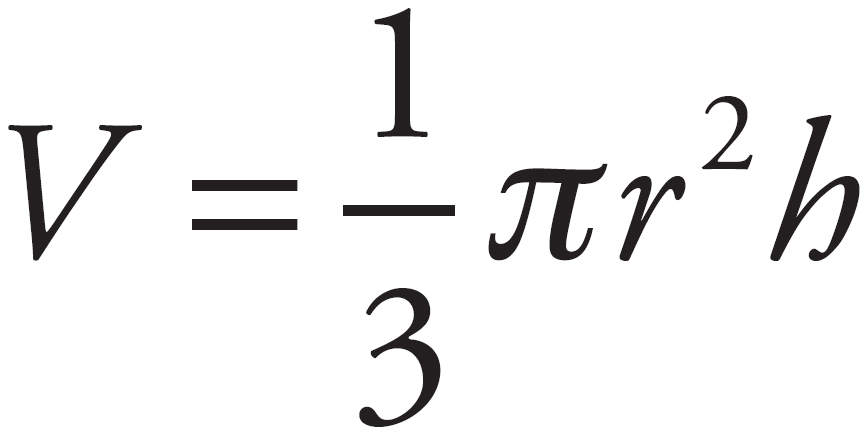 . The question says that the volume is 100π, so plug this in to get
. The question says that the volume is 100π, so plug this in to get 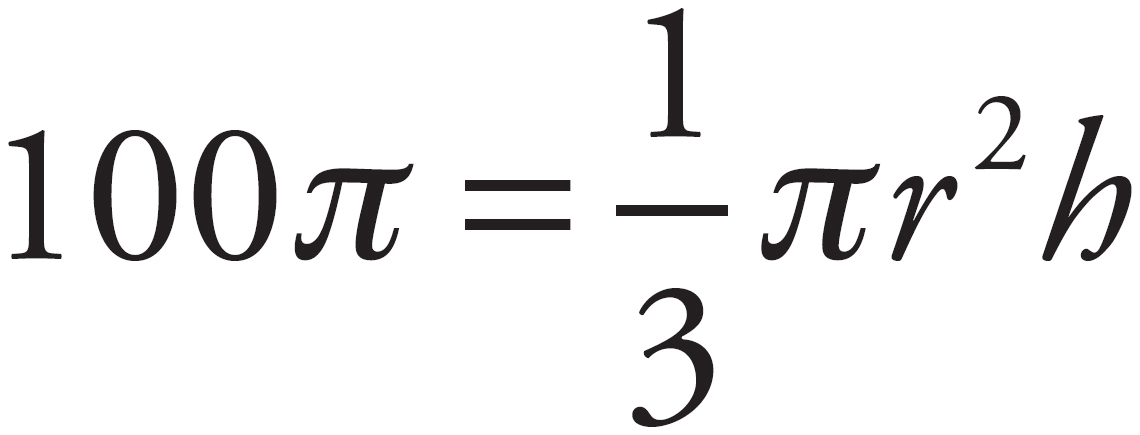 . The questions asks for h, so you’ll need to determine the value of r. The question also says that the area of the circular base is 25π. The formula for the area of a circle is A = πr2. Plug in A = 25π to get 25π = πr2. Divide both sides by π to get 25 = r2. Take the square root of both sides to get 5 = r. Plug r = 5 into the volume formula to get
. The questions asks for h, so you’ll need to determine the value of r. The question also says that the area of the circular base is 25π. The formula for the area of a circle is A = πr2. Plug in A = 25π to get 25π = πr2. Divide both sides by π to get 25 = r2. Take the square root of both sides to get 5 = r. Plug r = 5 into the volume formula to get 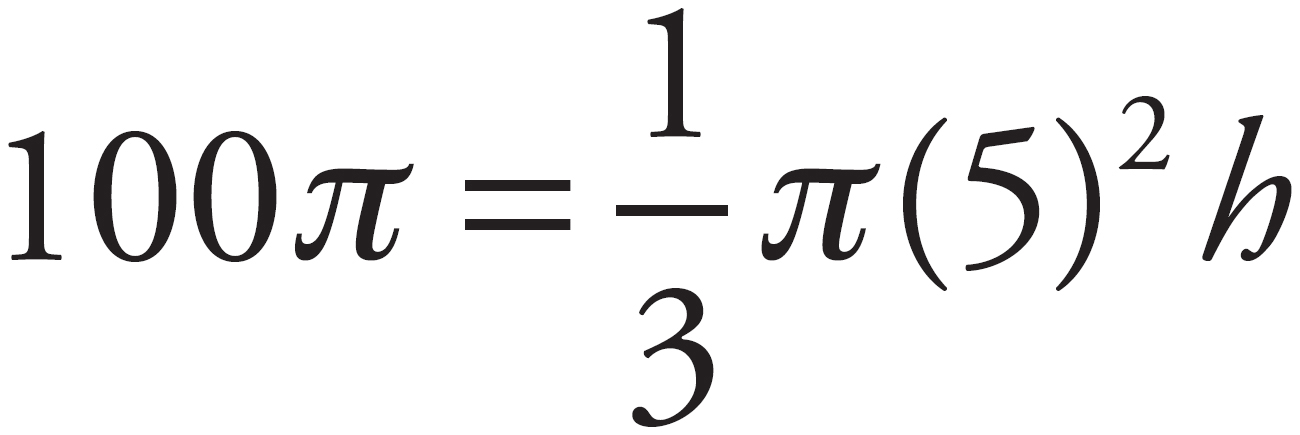 . Simplify the right side to get
. Simplify the right side to get  . (Alternatively, note that A = πr2 and plug 25π into the formula directly bypassing the need to find the radius.) Multiply both sides by
. (Alternatively, note that A = πr2 and plug 25π into the formula directly bypassing the need to find the radius.) Multiply both sides by  to get
to get  . The correct answer is (C).
. The correct answer is (C).
8. B
The formula for volume of a sphere is  . Plug in V = 36π to get
. Plug in V = 36π to get  . Divide both sides by π to cancel the π’s and get
. Divide both sides by π to cancel the π’s and get  . Multiply both sides by
. Multiply both sides by  to get
to get  . Take the cube root of both sides to get r = 3, which is (A), but this is not the answer. The question asks for the diameter. Since d = 2r = 2(3) = 6, the correct answer is (B).
. Take the cube root of both sides to get r = 3, which is (A), but this is not the answer. The question asks for the diameter. Since d = 2r = 2(3) = 6, the correct answer is (B).
1. C
To find the slope, take the difference in y-values, and put that over the difference in x-values. In this case, that is  or
or  .
.
2. C
Did you need the distance formula this time? No way! The y-values were the same for both numbers. All we had to do was subtract 5 from 12. If you didn’t notice this, you could have sketched it out. Seeing what the problem really looks like almost always makes it easier to solve.
3. To graph point A, count 3 left and 4 down. To graph point B, go right 2 and up 3. For point C, count 3 right and 5 up.
1. A
You want y = mx + b form, in which m is the slope and b is the y-intercept. The question says that the slope is 4, so plug this in for m. Since at the y-intercept, the x-coordinate is 0, the (0, –2) represents the y-intercept, so plug in –2 for b.
2. 
You want y = mx + b form, in which m is the slope and b is the y-intercept. First get the slope. Plug the points you have into the slope formula to get  . Select this for the first box. To get the y-intercept, plug in the slope and one of the points into the slope intercept form to get
. Select this for the first box. To get the y-intercept, plug in the slope and one of the points into the slope intercept form to get  . Solve to get b = 1. Select this for the second box.
. Solve to get b = 1. Select this for the second box.
3. C
You want y = mx + b form, in which m is the slope and b is the y-intercept. Since the slope is –2, the equation is in the form y = –2x + b. Plug in the point (–1, 3) to get 3 = –2(–1) + b. Solve to get b = 1, so the equation of the line is y = –2x + 1.
4. A
Get the two equations into y = mx + b form. The first equation, 2x + 8y = –5, can be put into the form  . The second equation, 3x + 12y = 8, can be put into the form
. The second equation, 3x + 12y = 8, can be put into the form  . Since the slopes are the same, the lines are parallel.
. Since the slopes are the same, the lines are parallel.
5.
You are given the equation of the line in y = mx + b form: y = –2x + 4. Therefore, the slope is –2 and the y-intercept is 4. Mark the point (0, 4), since this is the y-intercept. Since the slope is –2, mark the point that is up 2 and left 1, (–1, 6). Now, go in the other direction and mark the points that are down 2 and right 1: (1, 2), (2, 0), (3, –2), (4, –4) and (5, –6).
1. 12
The speed traveled is equal to the slope of the line. To get the slope, you need two points, so use the points (0, 0) and (5, 60). The speed is  .
.
2. B
Each box contains 2 red marbles and 5 black marbles, so the number of red marbles must always be a multiple of 2, and the number of black marbles must always be a multiple of 5. Start with one box. If a customer buys one box, he or she will have 2 red marbles and 5 black marbles. The only graph that has this point is (B).
3. greater than
To get Lisa’s speed, find the slope of the line. Use the points (0, 0) and (2, 100) to get a speed of  . To get Frank’s speed, take the coefficient on t, which is 40. Therefore, Lisa’s speed is greater.
. To get Frank’s speed, take the coefficient on t, which is 40. Therefore, Lisa’s speed is greater.
1. C
A graph is negative when it is below the x-axis. Look to see where the graph crosses the x-axis. This happens at x = 3 and at x = 9. Between these points is where the graph is below the x-axis and, therefore, negative.
2.
Since the equation of the line is in y = mx + b form, the y-intercept is represented by the b term, in this case 4. Therefore, the y-intercept is the point (0, 4). To get the x-intercept, set y = 0 to get 0 = 2x + 4. Solve for x to get x = –2, so the x-intercept is the point (–2, 0).
3. B
Find the peaks and valleys. In this case, there is only one of each. The graph hits a valley, i.e. a relative minimum at the point (–3, –4) and a peak, i.e. a relative maximum, at the point (2, 6). The graph is increasing between these two points, so over the interval –3 < x < 2.
4. C
The axis of symmetry is the line that divides the curve into two mirror images. Sketch the graph on scratch paper and draw each line from the answer choices. The only one that divides it into mirror images is y = 3.
5. B
To determine the period, find the peaks in the graph. The graph reaches peaks at (–7, 2), (–1, 2), and (5, 2). Since the distance between each of these peaks is 6, the period is 6.
1. D
3 is the diameter, so the radius is 1.5. Use the area formula and then multiply by  .
.
2. A
The area is 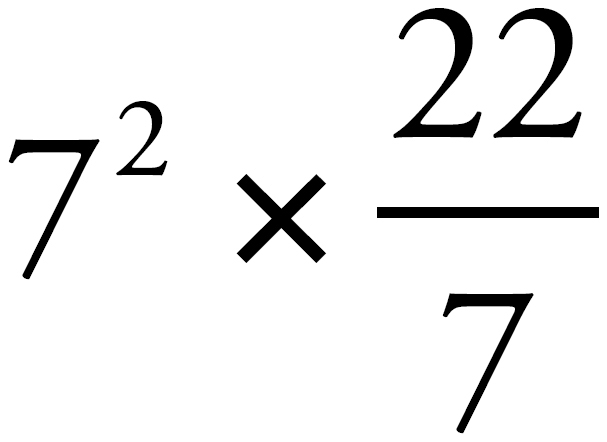 , or 154.
, or 154.
3. B
Each side of the square has the same length, 3. The two sides of an isosceles triangle that are opposite equal angles also have the same length, 4. The correct answer is 3 + 3 + 3 + 4 + 4 = 17, which is (B).
4. C
Any three-sided figure is a triangle. If two of the sides have the same length, as the ratio tells you, then it is an isosceles triangle.
5. A
You could backsolve this. The volume of a cube is side cubed. Try cubing each answer choice until you find one that gives you the value 27. Obviously, you won’t have to go too far to realize you are going to need a pretty small number.
6. B
The sum of all three angles must equal 180, so subtract 45 from 180.
7. D
Divide 168 by 12. The correct answer is 14.
8. A
The area of a triangle equals the base times the height divided by 2, which is the same as  times the base times the height.
times the base times the height.
9. D
The diameter of the large circle equals the sum of the diameters of the two small circles, so each small circle has a diameter of 10 and a radius of 5.
10. D
You need two points on a line to find its slope.
11. B
Get the line in y = mx + b. Start by getting the slope. The slope is  . Now plug this in for m and the point (1, 2) in for x and y into the equation to get 2 = –2(1) + b. Solve for b to get b = 4, so the equation is y = –2x + 4.
. Now plug this in for m and the point (1, 2) in for x and y into the equation to get 2 = –2(1) + b. Solve for b to get b = 4, so the equation is y = –2x + 4.
12. A
To determine where a graph is positive, start with where the value is 0, i.e. the x-intercepts. The x-intercepts are –9.5, 1, and 8. The graph is above the x-axis, and therefore positive, between –9.5 and 1 and to the right of 8. Therefore, it is positive when –9.5 < x < 1 and when x > 8.
13. D
Both the area of the hexagon and the formula for area are given, so set 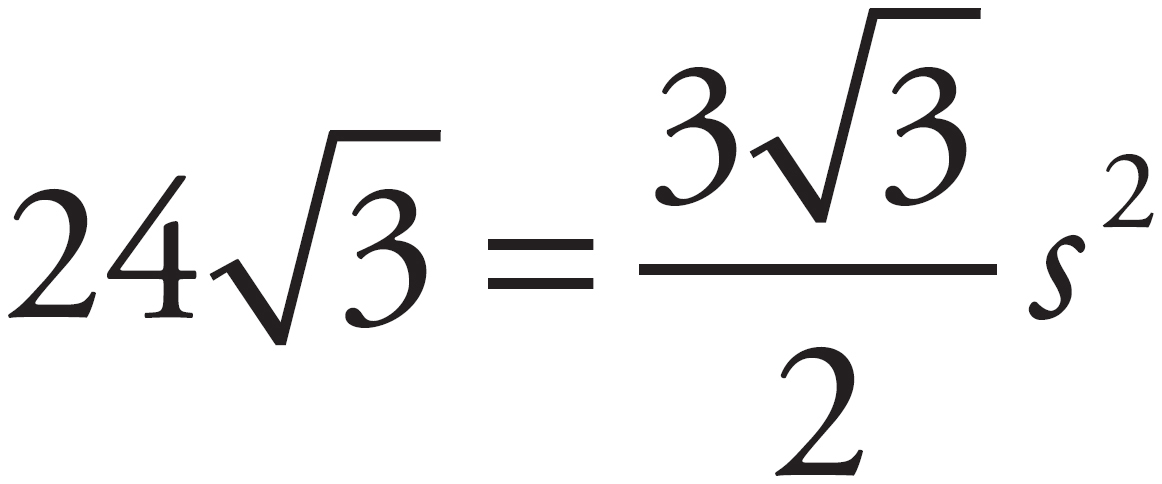 . Multiply both sides by 2 to get
. Multiply both sides by 2 to get  . Divide both sides by
. Divide both sides by  to get 48 = 3s2. Divide both sides by 3 to get 16 = s2. Take the square root of both sides to get 4 = s. This is (B), but the question asks not for the length of the side but for the perimeter. There are six sides in a regular hexagon and all sides are equal; the perimeter is 6s = 6(4) = 24. The correct answer is (D).
to get 48 = 3s2. Divide both sides by 3 to get 16 = s2. Take the square root of both sides to get 4 = s. This is (B), but the question asks not for the length of the side but for the perimeter. There are six sides in a regular hexagon and all sides are equal; the perimeter is 6s = 6(4) = 24. The correct answer is (D).
1. B
Although the printing is hard to read because some letters were missing, added, or switched by the early technology, an ad trying to sell fruits, (A), would include different information, including the price and type of produce. Celebrating bravery, (C), may make sense with the graphic and the words “exciting” and “fame,” but not with “fruites by planting.” The same logic goes for (D) raising money for shipbuilding. The ad is offering an exciting opportunity for people to travel to the new colony of Virginia across the Atlantic Ocean, (B).
2. A
The text at the bottom of the ad tells you that it was printed in London, England, (A). But if you figured out its purpose in question 1, you would be able to eliminate people already in the colonies [Jamestown, Virginia, (B), a New England colony, (C)] and workers in shipyard, (D).
1. The preamble includes several action words describing what the Constitution is intended to do, but the final words of the document enact it: “do ordain and establish.”
2. C
Each verb in the preamble is something that the nation will do to live up to its principles, so (C) is the correct answer. You can also eliminate declaring independence, (A), because that action happened earlier in the Declaration of Independence. You should also know that slaves were not freed in the American colonies, (B), but much later during the Civil War between the states. Lastly, the Constitution sets up the structure of government to which the people elect their representatives; it did not appoint people to positions, (D).
1. The passage states that the history of the United States. “separates [it] from the past and connects [it] with the future only.” This should lead you to select this statement as the one that doesn’t belong: “The greatness of the United States is its connection to the past.” Additionally, the first line of the passage mentions that the American people come from other nations, that is, they are immigrants. You can also find equality as the founding principle of the nation in the first line of the passage.
2. D
The passage states that the development of the United States will be separate and different from other nations and the past, so you can eliminate (A). There is no mention of either economy or empire in the passage, so neither (B) nor (C) describes the destiny of the United States. The passage presents a “new history” developing the values of democracy, so (D) is the answer.
1. C
This is the key phrase in the document: “all persons held as slaves within any State or designated part of a State, the people whereof shall then be in rebellion against the United States, shall be then, thenceforward, and forever free.” From this, you can eliminate (A) and (B) because you know that the Civil War was going on, and the Southern states were already in rebellion or withdrawn from the Union. The document also declares certain slaves (in states in rebellion) “forever free,” so you can eliminate option (D) in favor of option (C).
2. The authority of the document is Lincoln’s position as president and commander-in-chief of the armed forces; he invokes this authority here: “the Executive Government of the United States, including the military and naval authority thereof, will recognize and maintain the freedom of such persons.”
1. B
The sign in the back of the drawing names the scene “After Great War Reconstruction.” The Civil War was not a fight between the Republican and Democratic parties, but rather between Northern and Southern states. Deciding how to move the country forward after this war during the Reconstruction was a “partisan fight.” World War One and the American Revolution also have nothing to do with political parties in the United States.
2. Skeptical, doubting. The cartoon depicts an active scene in which no work is getting done. The worker in the background is watching the fight and waiting for these two parties to “get to work.” This expresses a skeptical or doubting attitude towards the “work” of Reconstruction.
1. The right to vote. “Suffrage” means the right to vote, and “ratification” means signing an agreement to pass a law or amendment. These labels lead to the correct selection (the right to vote) and eliminate the other options that are not pictured in any way in the drawing.
2. A
Ratification involves getting ¾ of the states to pass an amendment, so the answer is (A). If you didn’t know this term, you could try reasoning away the other options: Measurements, (B), don’t fit with any political message that you would find in a political cartoon, and if the numbers were years, (D), they would not correspond to the date of the cartoon (1919). Numbers of women may seem possible, (C), but it’s not clear how such a small number of individual women might fit in the picture.
1. Nations fight over other lands to grow their own empires; this is called imperialism.
2. Alliances are what drag countries into wars to defend their allies.
1. 1933
The graph is showing the U.S. unemployment rate, so the highest point would indicate the highest number of people unemployed. This would be 1933.
2. C
When trying to identify the fastest rate of decline, you are looking for the steepest downward slope of the line. This happens from 1940–1942, or (C).
1. B
The date of December 7, 1941, is located within the speech, so this should help you identify the event as the attack on Pearl Harbor, (B). Since the president is addressing Japanese aggression on U.S. territory, you can eliminate the other options.
2. The President frames the U.S. response as defensive against Japanese aggression in the following phrases: “measures be taken for our defense,” “overcome this premeditated invasion,” “defend ourselves to the uttermost,” “unprovoked and dastardly attack by Japan.”
1. A proxy war is fought between two parties through others, so the Korean War (1950) would be an example of this, since those fighting were supported by the United States and Soviet Union. Launching a satellite into space (1957) would be part of the space race. Avoiding nuclear war in the Cuban Missile Crisis (1962) demonstrates the stakes of mutually assured destruction.
2. D
The timeline specifies that the Iron Curtain was “across Europe,” so that helps you eliminate (A) and (B). The Cold War had nothing to do with temperature, so you should also be able to rule out (C). The main conflict of the Cold War was between Western capitalist democracies and Communism, so you should select (D).
1. The numbers of people participating in the Montgomery Bus Boycott support the first statement. There are plenty of documented examples of nonviolent disobedience used to protest, so this statement is also based on evidence. The timing of JFK’s push for civil rights legislation and his own official statements support the last statement. Stating that something “would have” been different in history requires speculation, so this statement is based not on fact, but on opinion: “If the Voting Rights Act had been passed before 1965, the Civil Rights Movement would have ended earlier.”
2. C
Choices (A), (B), and (D) are actions that violated laws during the time of the Civil Rights Movement, so these would be acts of nonviolent civil disobedience. Choosing not to use a service in a boycott, (C), is not against the law and therefore not nonviolent civil disobedience.
1. B
During the Vietnam War, young men protested the draft that randomly selected them for mandatory service, (B). Protests against the war itself used other slogans, so you can reason that (A) and (D) are not correct. Protests about age restrictions had to do with voting, not military service, so (C) also does not align with the picture.
2. D
The slogan has to do with young men being called to fight when they were not old enough to vote, so these protests pushed for lowering the voting age to 18. The Voting Rights Act, (A), concerned racial discrimination in voting, and universal suffrage, (C), removed the property requirement to extend voting rights to all white men during westward expansion. Poll taxes, (C), charging people to vote, had nothing to do with age, so you can eliminate this answer also.
1. B
The president calls for a “global free trade zone” in which government does “not stand in the way.” A regulatory structure, (A), tariffs supporting American businesses, (C), and new laws negotiated between nations, (D), would be stepping in the way of the free market, so you can eliminate these answers and select (B).
2. Globalization. Since the speech focuses on encouraging a global free market, isolationism and nationalism do not make sense, since these have to do with promoting U.S. interests only. The president also speaks directly against creating bureaucracy, so you can eliminate this answer also, and select globalization.
1. The date September 11 is known for the terrorist attacks crashing hijacked planes on U.S. targets, (C). The 9/11 attacks also prompted the War on Terror declared in this speech.
2. A
The president states, “Every nation, in every region, now has a decision to make. Either you are with us, or you are with the terrorists.” This statement supports (A). He also makes clear that the war will not be one battle or series of airstrikes, so you can rule out (C) and (D). The locations of all terrorist leaders were not known at this time, so (B) does not make sense.
1. Totalitarian rule means no individual freedom to enable absolute control.
2. Representative democracy. Direct democracy involves citizens in the decision and law-making process. Since Britain has elected officials representing groups of people, it is a representative democracy. You can also rule out the other two options: communism has to do with state control of the economy, and authoritarian government is about imposing state control over citizens’ lives (not representation).
1. The basic power of the executive branch is to sign bills into law. Declaring war requires a vote in Congress. Laws are also introduced in Congress. And it is the power of the judicial branch to review and rule that laws are unconstitutional.
2. A
The fundamental difference between the Senate and the House is the number of representatives: two senators are elected by each state, while representatives are elected by their home districts, which vary by population.
3. D
The passage describes what happens to a bill after it has passed in Congress, so you can rule out (C). The bill is going to the president who signs it into law or vetoes it. The passage is not describing the removal of the president, (A). Laws are declared unconstitutional by the Supreme Court, (B), which is not mentioned here. The correct answer is (D).
1. B
Women gained the right to vote in 1920, so identity as a woman, (A), would no longer prevent someone from voting in 1950. Poll taxes were not abolished until 1962, so it is possible that someone could not afford to vote in 1950, making (C) correct. You can also rule out age of 21 years, (C), since this was the original voting age, and slave ancestry, (D), which was no longer a factor after the 15th Amendment in 1870.
2. B
The first amendment protects an individual’s right to free speech, freedom of the press, and religious expression; the second amendment protects the right to bear arms.
3. D
The quote states that “separate schools for white and colored children, has been held to be a valid exercise of legislative power.” The words “separation” and “power” make (B) tempting, but this a trap. It cannot be (C), since the quote states that limits to contact “do not necessarily imply the inferiority of either race to the other.” On the other hand, the civil rights movement had not gained any influence until the 1960s, so rule out (A). That leaves (D). The quote states that separate schools are “valid,” but that this does not imply “inferiority.”
1. D
For this question, we are interested only in the northeast region, represented by the figure on the left. Just subtract the ’09 figure from the ’10 figure. Calculate as follows: 9.1 – 7.3 = 1.8, or (D).
2. A
This is a tough evaluation problem that requires you to make generalizations about the economy based on unemployment figures. If a country’s unemployment figures are up, we can make a general assumption that the country’s economy is not healthy. Of course, from this chart, we have no idea about the economies of other nations. According to the data in the chart, the unemployment rate in 2010 was higher than it was in 2009. From this data, we can infer that the overall economic situation was worse in 2010 than it was in 2009.
1. B
The Atlantic Ocean is the continuous body of water, North between the East Coast of North America and Europe, South between South American and Africa.
2. Australia is the only continent that lies completely within one quadrant of the globe. It is both south of the equator (0 degrees latitude) and east of the Prime Meridian (0 degrees longitude).
3. C
Mountain ranges would be represented not by a single line, and rivers do not run directly North-South. Climate zones correspond to latitude lines, relative to the equator. The lines separate the time zones, (C), from west to east: Pacific, Mountain, Central, Eastern.
1. A
Notice that the arrows are pointing in different directions. An export is a good that a country sends TO another country, not something that it receives. The arrow going from the colonies to Britain lists “tobacco” as one of the exports, so (A) is the best answer. Manufactured goods, (B), are an import from Britain, not an export from the colonies. Slaves, (C), are imported from Africa, and sugar, (D), is imported from the West Indies.
2. A
Recalling that World War II took place during the 1940s will help you to select (A). Otherwise, use POE. Choice (B) is a trap, since the graph measures employment, not population. The Great Depression was in the 1930s, not the 1940s, so rule out (C). Choice (D) is not true, since civilian employment was low throughout the early part of the graph. Also, we cannot say what is true of employment in the years not measured by the graph.
3. TRUE: Statements (a), (b), and (c). All of the countries listed on the right side of the map (the East) are European countries, so statement (a) is true. Italy had over 4,000,000 immigrants, while Ireland had less than 2,000,000, so this ratio is at least “2 to 1” (two times bigger). According to the numbers for Japan and France, Japan is slightly higher at 241,000, so statement (c) is true. Statement (d) is deceptive. It certainly looks like Japanese and Chinese immigrants largely landed in the West, but we do not know where they ultimately “settled.” Many of them may have migrated East after they landed. Statement (d) is FALSE.
1. D
In order for the bird to be found in the lava from the Pompeii eruption, the bird must have lived during that period or it would not end up preserved in that rock—(D) is correct. This was an evaluation question. The passage mentions that the bird’s species is believed to be extinct, but there is no mention of how this happened and we cannot assume that the extinction was due to the volcano, so eliminate (A). While it is possible that the bird did not live in Pompeii and was just caught in the wrong place at the wrong time, this is unlikely and cannot be determined from the information in the prompt, so eliminate (B). Choice (C) does not define whom it is referring to (no one who lived in Pompeii or no one in general). Obviously the eruption did not kill all humans or we would not be here today. Also, the passage doesn’t mention the extent of the casualties at Pompeii, so eliminate (C).
2. The only two observations are that the bird’s wings are abnormally long and that Mount Vesuvius erupted in 79 A.D. The belief that the bird would have been able to eat more than its competitors is a conclusion that the scientists could have made based on its unique beak. Finally, (c) is not supported by the passage and does not fit into either category.
1. D
According to the passage, bacteria that keep glowing are still alive so the drug must not be able to kill them. There are two possible explanations for this; first, the drug may not be the correct type (as the passage explains, it is imperative that the correct drug be chosen based on the particular strain) or, secondly, the drug might not have been administered at a high enough dose [(D) is correct while (A) and (C), while correct, do not include the other option and are eliminated]. If the cell continues to fluoresce, it must not have been destroyed—eliminate (B).
2. A
Timing is critical to the test so that the patient can be placed on the correct course of treatment as soon as possible to prevent the spread of infection [(A) is correct]. Choice (B) is a nice feature of the new test but certainly not the most important reason, so eliminate (B). There is not enough information in the passage to know how long the enzyme lasts but, even if this were true, it would not support the need for expediency with respect to the test, so eliminate (C). Choice (D) is vague and can be eliminated since the passage does not specifically describe other types of bacteria.
3. The 10,000 mM point on the x-axis should be clicked on as this represents the dose at which the intensity falls below 20, which the question stem indicates is acceptable.
1. 75%
This question wants you to look at the Punnett Square and figure out how often an offspring will have pointy ears. The information in the passage states that the trait will be expressed if the gene is pure or composed of mixed alleles. Accordingly, the probability a cat will have pointy ears is  or 75% or 0.75.
or 75% or 0.75.
2. A
You need to understand how a Punnett Square works in order to answer this question. You must cross each column with each row in order to find the possibilities; e.g., the first column, which has the allele P, is crossed with the first row, which also has the allele P, to give us the gene PP. Thus, the answer is (A).
3. The genotypic ratio is the pattern of offspring distribution based on genotype. In this example, we have one instance of PP, two instances of Pp, and one instance of pp. Thus, the genotypic ratio is 1:2:1.
1. A
In order for some life forms to survive, they would have needed to have the ability to survive despite the conditions described in the passage. One such ability would be to be able to survive without sunlight—(A) is correct. The dinosaurs went extinct; they did not hibernate. If this was true, we would expect to still see dinosaurs, so eliminate (B). As we know, sunlight is critical to the survival of plants, which use it for photosynthesis—eliminate (C). There must have been some food on the planet or else no organisms would have survived, so eliminate (D).
2. C
This is a good example of a fifty-fifty question because you can probably eliminate two answer choices immediately by thinking about the question. Darwin would very likely agree with this passage because of his belief in natural selection and the conditions under which it occurs. Moreover, he did not believe in destiny—so eliminate (A)—or consider tragedy in his theory, so eliminate (B). Choice (C) closely describes Darwin’s views—(C) is correct—while (D) implies that evolution took place at the level of individual organisms, a common misconception about Darwin’s theory, which described species and populations but not individuals. Eliminate (D).
1. B
The passage states that the tree was cut down at the end of the growing season in 2000, meaning that the outermost ring must correspond to the growth that took place in 2000. You can see that the second-most outer ring has a larger size than this and the next two closest to it, which represent 1998 and 1997, respectively. Therefore, (B) (1999) is the correct answer.
2. C
Counting the rings reveals that there are 8 complete rings; hence the tree is 8 years old. Choice (C) is correct, so eliminate the other answer choices.
3. The correct answers are, in order, independent and dependent.
1. C
Use the arrows to determine which organism is consuming the other. The arrow originates at the organism that is getting eaten and terminates at the organism that is preying on it. The only organism that is eaten by both land and sea creatures is the salmon, which is eaten by both bears and sharks, so (C) is correct. Minnows are eaten only by sea creatures, so eliminate (A). Wolves are eaten only by bears—eliminate (B)—and groupers are eaten only by sharks, so eliminate (D). Note that (B) and (D) could be elimi-nated immediately because they are eaten only by one animal.
2. D
The absence of algae, (D), would have the greatest impact on the rest of the food chain since it is a primary producer.
3. Primary producers: algae. Primary consumers: copepods, minnows. Secondary consumers: salmon, groupers. Tertiary consumers: sharks, bears, barracuda, wolves.
1. Based on the passage provided, the muscular system allows the body to move, the skeletal system works in conjunction with the muscular system to enable movement, and the nervous system regulates both voluntary and involuntary motion. Thus, the correct answers are (b), (c), and (e). Neither the endocrine nor the digestive system is mentioned in the passage and, therefore, neither is incorrect.
2. We are told that Susan suffered from a heart attack, which would primarily impact the cardiac, or heart, muscles within the muscular system.
3. D
According to the passage, the nervous system controls your muscular system and regulates both voluntary and involuntary motions by sending signals to parts of the body. Therefore, prior to the act of running, the nervous system must send signals to the muscular and skeletal systems. Thus, (D) is the correct answer. Don’t fall for (B), as this is a trap! The question states that the endocrine system initiates the flight-or-fight response, not the movement itself.
1. Based on the passage provided, bacterial infections, unlike viral infections, are living. Therefore, if the disease is alive, it is bacterial. The passage also states that bacterial infections can be treated with antibiotics. Thus, the disease is alive and can be addressed with antibiotics; i.e., bacterial and antibiotics are correct.
2. According to the passage, the majority of individuals infected drink water from the same well and work with goats. Thus, the likely mode of disease transfer involves drinking contaminated water and exposure to infected animals. Choice (a) aligns with the contaminated water theory and, therefore, is correct. There is no indication that the disease is airborne, blood-borne, or transferred via human saliva, so eliminate (b), (c), and (e). The only other option is (d), the bite of an infected animal. Since we are told that the infected are exposed to goats, which could transfer disease via the bites of infected fleas, (d) is also a potential method of transfer.
3. C
According to the passage, a viral infection can be prevented via the use of vaccination. Thus, eliminate (A). Quarantining animals and avoiding contact with infected persons can prevent the spread of disease by eliminating contact, so (B) and (D) can be eliminated. The passage also states that bacterial, not viral, infections can be treated with antibiotics. Therefore, (C) is correct.
1. According to the passage, an exothermic reaction occurs when heat is released in an energy transfer, while an endothermic reaction occurs when heat is absorbed in the energy transfer. When Eliz and Kristy started the fire, heat was released into the atmosphere. Thus, an exothermic reaction took place because heat was released.
2. B
Based on the passage, conduction occurs when objects are in direct contact with one another. Since Kristy and Eliz were not in direct contact with the fire, conduction did not take place. Therefore, you can eliminate (A) and (C). Choice (B) states that the girls absorbed heat, while (D) states that the campfire absorbed heat. Since Kristy and Eliz were the ones who became warmer and absorbed the heat, the correct answer is (B).
3. Here, you need to determine what happens when Kristy burns her hand. Since she uses a metal pole that is in direct contact with the fire, heat is transferred by means of conduction. Thus, select (a) and (e). Since an exothermic reaction occurs when heat is released to surrounding objects, which become warmer when they absorb the heat, the reaction is exothermic; heat from the fire was released and transferred to her hand. Thus, select (d).
1. To answer this question, break it up into the three parts. First, Bob is the only one pushing on the rock. He is providing a force and so is friction. Note that gravity is supplying a force in all the scenarios. In the second scenario, the first three forces are the same but now there is also the force from Barbara. Finally, when the rock is over the ledge, neither Bob nor Barbara is pushing. Gravity is still a force and so is air resistance.
2. A
Work is defined as the force (F) multiplied by the distance moved (d). Since the rock didn’t move, the work done is zero [(A) is correct].
1. According to the passage, electromagnetic waves pass through space, while mechanical waves require a medium. The passage also states that there is an inverse relationship between the frequency of a wave and its period. Therefore, as electromagnetic waves pass through space, the frequency of a wave increases as the period of a wave decreases.
2. In order to answer this question, you need to look at the “Applications” section of the provided table and select waves that relate to medical research. According to the chart, Visible Light is used in physical therapy, Ultraviolet Light is used in sanitation and air purification, and both X-Rays and Gamma Rays are used to treat cancer. Thus, you should select (c), (d), (e), and (f).
3. Here, you need to use the table to find the wave type that corresponds to a wavelength size of 1 nm. Make sure you don’t fall into the trap of reading the wavelength size as 1 mm, as the question asks about nanometers, not millimeters. According to the table, a wavelength size of 60 nm – 1 × 10–4 nm is associated with X-Rays. Thus, the correct answer is X-Ray.
1. The correct sentence reads as follows: Increase the pressure and decrease the temperature.
2. A
Saltwater boils at a higher temperature than freshwater. This is due to a colligative property. The salt dissolves into its constituent ions in the water and the charged ions anchor water molecules down in the liquid. This means that it takes more energy for the water molecules to escape into the gas phase than normal. As a result, the boiling point is increased—(A) is correct. The water can still boil; it just takes longer, so eliminate (B). Also be wary of extreme wording in answer choices such as this one. Water is already neutral—eliminate (C)—and the fact that salt water is easier to float in has nothing to do with its boiling point, so eliminate (D).
3. A
This is a difficult question because you have to use the graph and then interpret your findings. Start by finding the first point (–70°C and 70 bar). This corresponds to solid carbon dioxide. If this solid CO2 is heated and kept at the same pressure, it will become a liquid. A solid-to-liquid phase transition is melting, so (A) is correct. Freezing is the opposite process, so eliminate (B). Boiling and condensing are processes that describe the phase transition that takes place between liquids and gases, so eliminate (C) and (D).
1. C
In this chemical reaction, 2Ag + H2S → Ag2S + H2, the sulfur atom is originally bonded to the hydrogen atoms. However, after the reaction takes place, the sulfur atom bonds to the silver atoms. Therefore, a single displacement occurs in this reaction; i.e., (C) is the correct answer.
2. A
In this chemical equation, 2Ag + H2S → Ag2S + H2, two atoms of silver combine with one molecule of hydrogen sulfide to produce one molecule of silver sulfide and one molecule of hydrogen. Therefore, (A) is the correct answer.
3. 6, O
In order to have a balanced chemical equation, the number of atoms associated with a particular element must be equal in both the reactants and the products. The balanced equation for photosynthesis is 6CO2 + 6H2O → C6H12O6 + 6O2. Notice that after the reaction occurs, 1 molecule of glucose is produced, which contains 6 carbon atoms. Since there are 6 carbon atoms after the reaction occurs, there must be 6 carbon atoms prior to the reaction occurring; thus, the first blank is 6. Furthermore, prior to the reaction, there are 12 oxygen atoms associated with carbon dioxide, 6 oxygen atoms associated with the water, and 18 total oxygen atoms. After the reaction, 6 oxygen atoms are associated with the glucose, leaving 12 unaccounted oxygen atoms; thus, the missing element for the second blank is O.
1. B
The figure shows that several earthquakes have taken place along the Western coast of the United States—eliminate (C)—and appear to follow a line down below that. Collectively, this suggests that there must be tectonic plates that rub together along this fault line, so (B) is correct. The map shows only the Americas, and there is no reason to suspect that this is the only location on Earth that earthquakes occur—eliminate (A). As the map indicates, more earthquakes occur in the United States than in Canada, so eliminate (D).
2. The correct answer would be to include tsunamis, tremors, damage to buildings, and volcanic activity in the drop box. These four outcomes are all mentioned in the passage as being caused by earthquakes, while the others—hurricanes and tornadoes—are not.
3. The correct answer is that the earthquake was probably low on the Richter scale (3) and deep because it was imperceptible and there was no sign of damage.
1. A
Glaciers are made of ice, which begins to melt once it warms up to slightly above zero degrees Celsius, so (A) is correct. Glaciers were found all over the earth but predominantly near the poles, not the equator, so eliminate (B). The opposite of (C) is true as well. As glaciers melt, the water that they were comprised of must go somewhere so it ends up in the oceans and other waterways, which causes their levels to rise—eliminate (C). Finally, while glaciers will certainly feel the gravitational pull of the moon, they are too large and heavy to be truly affected by it, so eliminate (D).
2. B
Glaciers move extremely slowly—eliminate (A)—and they are made up of fresh water, just like snow. Choice (B) is correct. Glaciers occur in many geographical locations—eliminate (C)—and there is no evidence to suggest that they will never again cover the earth, so eliminate (D).
3. You should select the peaks of the trend line, as these correspond to the times when the ice was thickest and were likely ice ages.
1. According to the passage, Bashville uses fossil fuels, which are nonrenewable energy sources, to power the town. Furthermore, the town is looking to decrease carbon emissions, by switching to renewable energy sources. Thus, select nonrenewable energy sources, as they increase carbon emissions.
2. C
Based on the passage, Bashville wants to reduce carbon emissions by switching from fossil fuels to renewable energy sources. Therefore, fossil fuels, such as coal, would produce the greatest amount of carbon emission. Choice (C) is the correct answer.
3. Here, you need to determine which renewable energy sources that Bashville could potentially adopt. The passage states that Bashville receives significant rainfall and is located in a basin surrounded by mountains. Thus, solar power and wind power are not viable options. Furthermore, the passage does not mention geothermal energy. Therefore, choices (a), (b), and (e) are incorrect. According to the passage, Bashville is located near a number of rivers and receives a significant amount of rainfall each month. Accordingly, (d), hydroelectric power, is a viable renewable energy option for the people of Bashville. The passage also states that Bashville is located in a large basin and the town wants to reduce the amount of organic waste. Therefore, choice (c), biomass, is also a potential renewable energy choice for Bashville.
1. The sentence should read as follows: The organic material found in rock layer C is probably older than the material found in layer A and younger than the material found in layer D. As the passage describes, the layers sediment over time so the oldest material will be on the bottom, while the youngest material will be on the top.
2. B
After one half-life has transpired, there will be half of the original amount left [(B) is correct and (A) and (D) are incorrect]. Half-lives do not change the element to something new and carbon-7 does not exist—(C) is incorrect.
3. D
It is unlikely that this area was once an ocean; (A) is false and eliminated. The rock layer could not have formed before the woolly mammoth roamed the earth, so eliminate (B). There is not enough information to determine when layer A formed, so eliminate (C). There must have been the appropriate conditions for fossilization, so (D) is correct.
1. According to the graph in the passage, the coldest planet is Neptune so the correct answer is to click on Neptune.
2. D
Being farthest from the sun, Mars has the longest orbital distance. Therefore, if all planets were to travel at the exact same speed, Mars would complete its orbit in the greatest amount of time—(D) is correct. Note that this question asks for an extreme answer. Even if you don’t know the right answer, you can eliminate the two answers that are not the extremes (Earth, Venus) right away.
3. C
The correct answer to this question will be one that is not supported by the evidence in the passage. Process of Elimination is a good strategy to use for questions like this one. According to the passage, the outermost planets are the larger ones, so eliminate (A). The graph indicates that the maximum temperature of Mars is less than Venus, so eliminate (B). The passage does not speculate on the likelihood of life on other planets—(D) is neither supported nor contradicted so it is eliminated. The passage states that the sun contains 99.9% of all mass in the solar system, indicating that it is about 1,000 times as massive as everything else in the solar system, not 100 times—(C) is false and therefore the correct answer.























































































